December 7th, 2020
1. The psychological approach to one's own person.
Photograph yourself in a self-chosen context and as an expression of an existential consciousness. Of course, the current corona situation, isolation, social poverty, lack of perspective, ... can play a role in this. But not necessarily !
How do you see yourself today? What do you want to reveal?
This part of the assignment is self-confrontational, autobiographical. First of all, try to be honest (to yourself).
2.Transform yourself into someone else.
Imagine yourself as someone else. Don't look into your own psychology but into someone else's (or someone else's outward appearance). Become that (imaginary) person.
This part of the assignment is about escapism and construction. You can 're-enact' a real person or you can make up the character completely.
We looked at the work of Lee Friedlander, Cindy Sherman, Yasumasa Morimura, Robert Frank, Robert Mapplethorpe, Samuel Fosso, Weegee, Jan Hoek, Claude Cahun, Duane Michals, Wolfgang Tillmans, Nan Goldin, Vivian Maier, Sam Taylor-Wood, Catherine Opie, Pixy Liao, Francesca Woodman, Frederic Pels, Valentina Stellino, Oxiea Villamonte, Jeff Wall, Hannah Wilke, Garry Winogrand, Diane Arbus, Kelli Connell, Larry Sultan, Agnes Lloyd-Platt, William Eggleston, Masahisa Fukase, Lee Miller, Martin Parr, John Coplans, Edward Weston, Nadar, Trish Morrissey, Carrie Mae Weems, Jo Spence, Andy Warhol, photos from a Hospital in Romania, Erwin Olaf.
|
A Lucia Fernandez
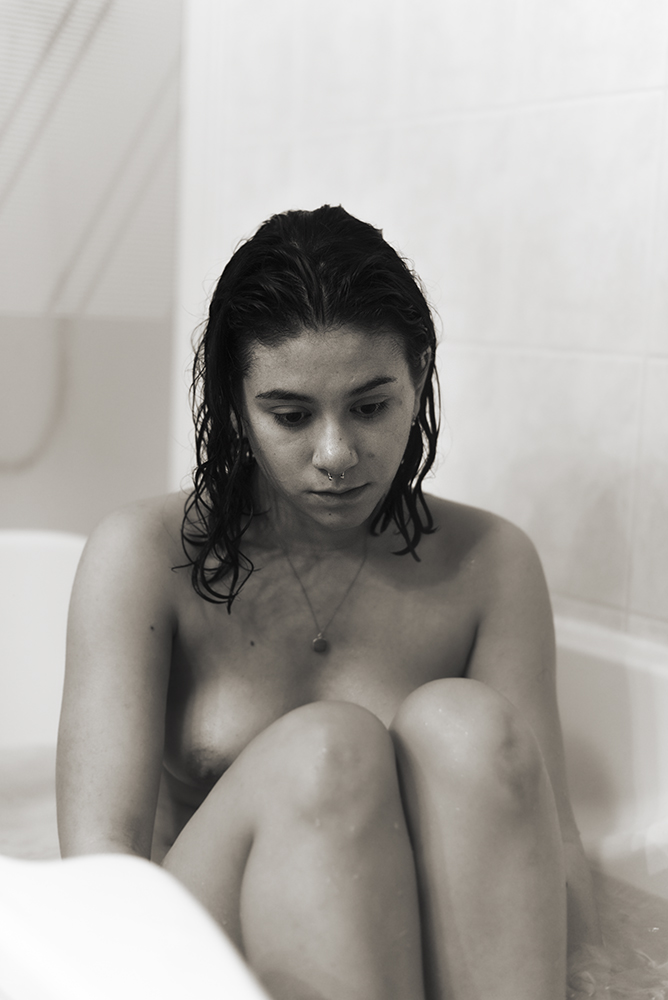
In a search for truth in a portrait, I always fall in the traps of vanity. In most of my self-portraits, I always try to show a self assured, confident woman. This could not be further from reality. For this image, I posed myself in the place where I feel the most comfortable, but at the same time most vulnerable. The camera’s voyeuristic eye sits in front of me in the most intimate situation that involves my body, and captures my modesty and insecurity.
After a lot of self reflection I decided to use this image, where I recognize those trades I always try to hide, but it comes with fear and apprehension. “A body is just a body”, but when you are a woman, especially a woman of colour, it is also political. I am aware to which extent I allow myself to disclose it, but at the same time, I ask myself what is the reason behind every inch of skin that I show. It almost feels like a conquest, where I regain the ownership of my image.
Although it can be seen as a narcissistic endeavour, self-portrait is about empowerment, and there is nothing more empowering than allowing yourself to exist in a world that wants to erase you.
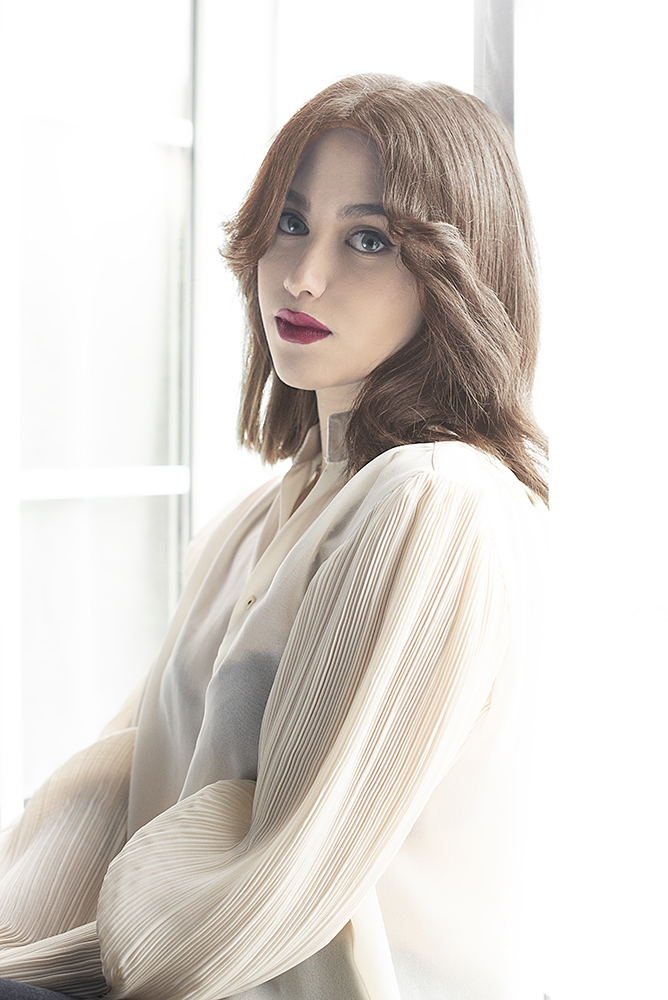
Since I discovered photography, I have used it as a way to explore my identity and my struggle to embrace it. In this image I present to you my alter ego, the I that only exists in my strongest desires to conform and belong in this society that has always told me that I am not beautiful enough. If my dad was white, if I was born in Europe, If I had a spot in this wide space that was constructed by oppressing my people.
To make these images I used a 50mm lens since it is the closest to human visual perspective. This way, the camera disappears and the view becomes almost ordinary. Like if you are in the space observing me, jugging me. The white represents the purity and the innocence that are always assumed from white women (Constructed identity) but also constructs a sterile, lifeless and aseptic environment that emphasises the awkwardness and distress of the portrayed (Real identity).
|
Alexia De Splenter
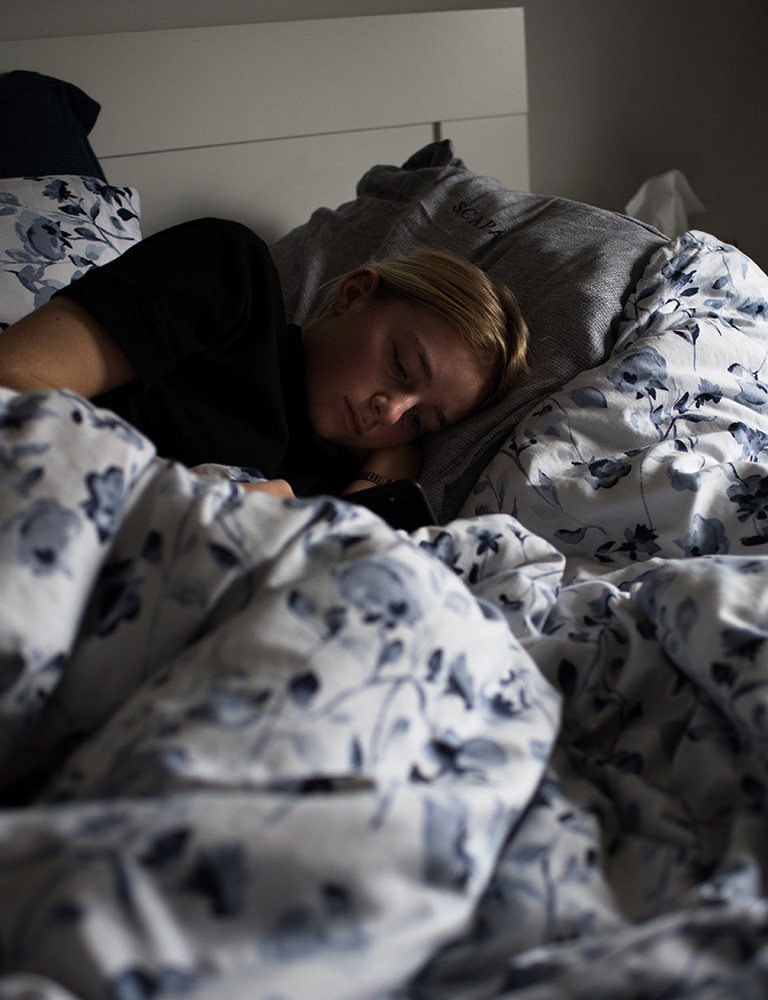
Elke dag, lange uren in men bed. Zo veel werk en tijd en toch niet vooruit geraken. Een sleur is het om me uit men bed te krijgen.
De ruimte: mijn bed is mijn veilig plaats. Niemand stoort me. Ik kan daar uren in liggen. Ja, ik geraak het beu maar de wereld buiten mijn interesseert me nu niet echt. Het is toch maar koud.
De manier: ik wou zeker een foto van uit mijn ooghoogte. De lakens met de plooien die onscherp vallen en het licht dat lichtjes op mij valt. Een realistisch beeld hoe ik mezelf zie liggen.
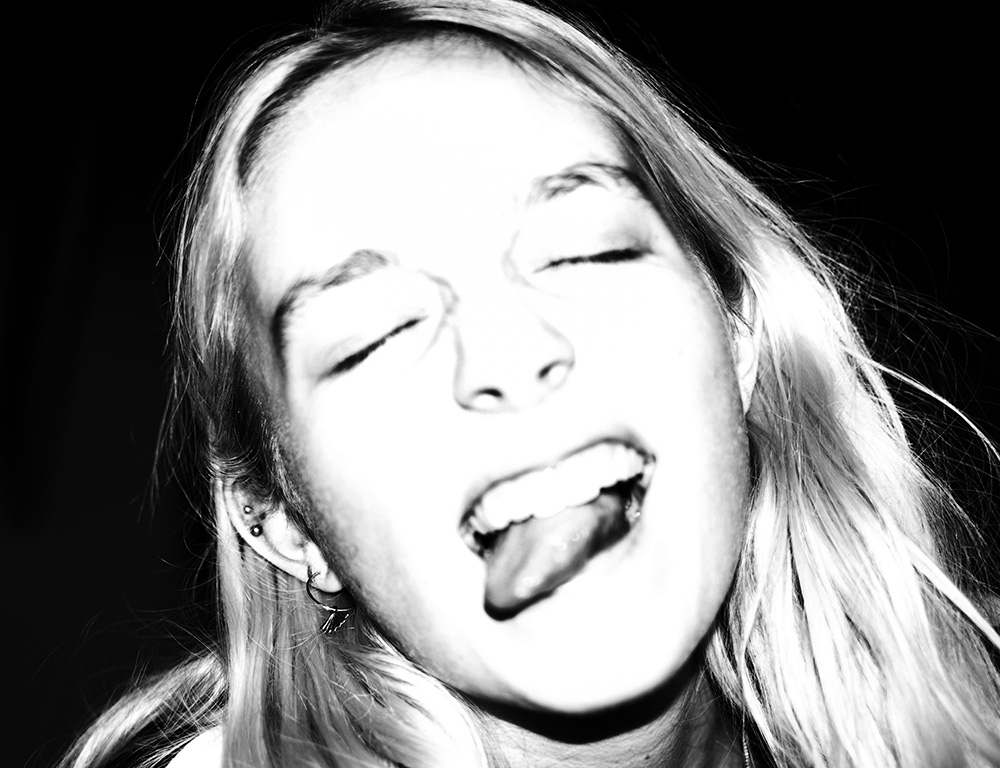
Ik heb niet een persoon gekozen maar een dier, mijn hond. Een van de enige waarvoor ik nog buiten komen en een lach op mijn gezicht zet. Tong uit en rollenbollen maar.
Ruimte: niet belangrijk, gewoon thuis
De manier: ik heb heel veel foto’s genomen waarop ik gekke bekken trek. De fot is in een zwaar zwart wit contrast. Mijn hond heeft twee kanten. Een gelukkige kant en een kant van ‘’laat me met rust’’.
|
Amber Van der Borght
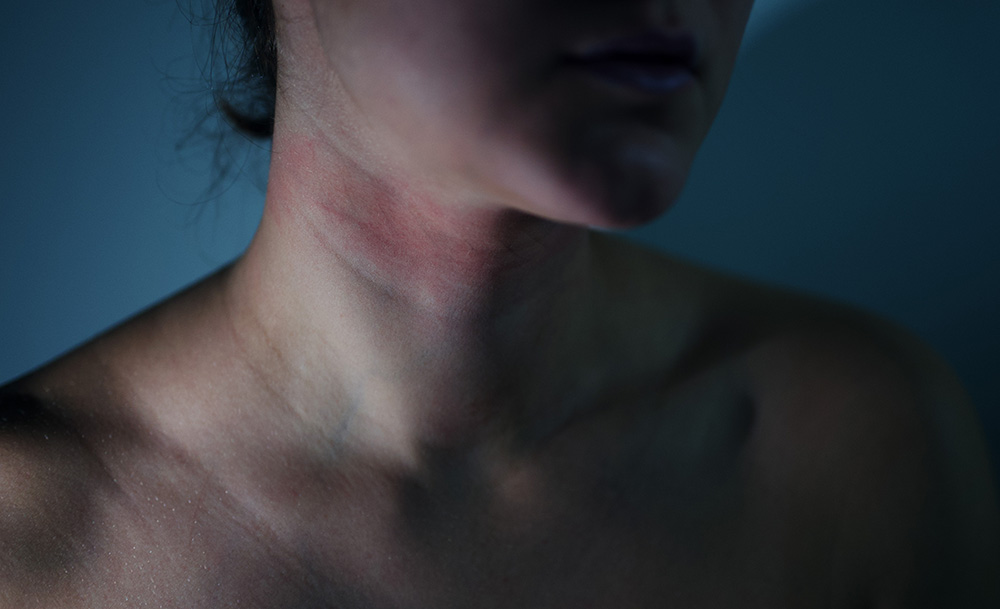
On the day we got this assignment, 2 years prior, my brother killed himself, and this is something us ‘survivors’ have to live with. This picture shows how, after 2 years, the wounds still feel fresh and nothing has been soothed or forgotten. The subtle marks and redness around my neck show the suffocation I also feel with having to carry this through life and dealing with what happened, there isn’t a day that goes by without me thinking of him or something else triggering the memories.
Only my shoulders are exposed, just like his were, when the paramedics stopped trying to reanimate him and covered him with one of our blankets. I chose not to show my eyes, because the agonizing hope of him opening his, wasn’t granted to us. The marks around his neck were engraved so deeply, it became something you couldn’t take your eyes off of. That is also the reason why I made it the point of attention.
This picture was taken at home with a dark background, not only did I find him when the sun had set, but this was by far the darkest period in my life.
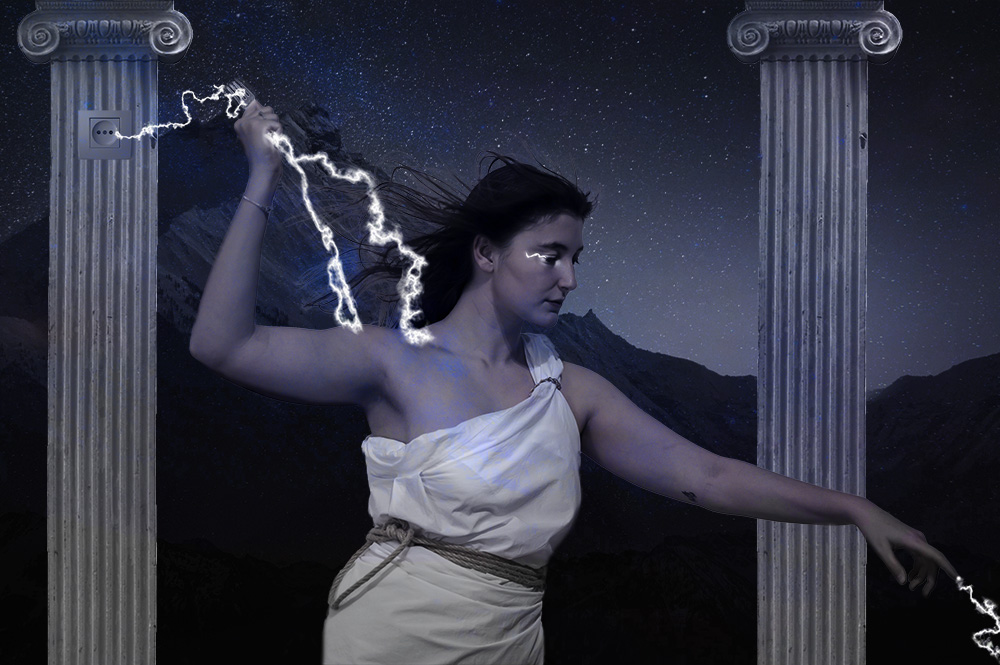
My ‘other’ I aspire to be, is Zeus. The Greek god was considered one of the most powerful in Olympus. I want to be powerful and strike down my insecurities and I’m looking down upon them, because I know I’m better and I shouldn’t let my way of thinking get me down. To make the picture more realistic, because Zeus is just a myth, I’m holding my fork towards a socket to generate electricity. Don’t try this at home.
I used my tripod, a timer and a hairdryer.
|
Anke Defossé
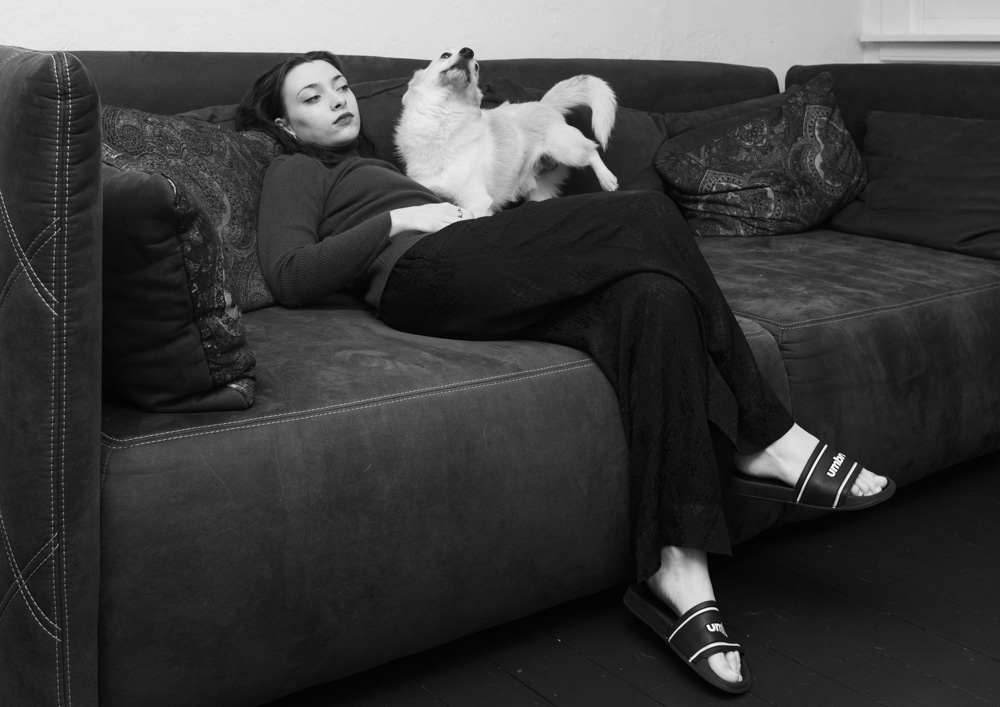
The psychological self-portrait is one I made with the idea of how I lived through the lockdown period. Every morning I woke up and would do everything I’d do on a normal morning. It shows how every morning I would shower, dress myself, do my facial routine, add some make up. Yet after that I found myself in the couch watching TV, waiting for a reason to go outside. The morning routing was a way of tricking myself. My dog has been very present in this period. Yet for the dog life became better during the lockdown. The contrast in emotion is visible in this image. I’ve chosen to do the portrait in the living room – the couch – because that’s the place I was drawn to most during the lockdown and also the most difficult place to leave.
I choose to put the image in black and white. The house I’m temporarily living in, is owned by my mother-in-law. She’s the one that has decorated the whole place and she loves everything in shades of grey. With that idea in mind I thought it was important to put everything in this ‘color’ scheme’. This to intensify the idea of blending in with the decor because I am spending so much time in it. I made the portrait in landscape to engage the surroundings more.
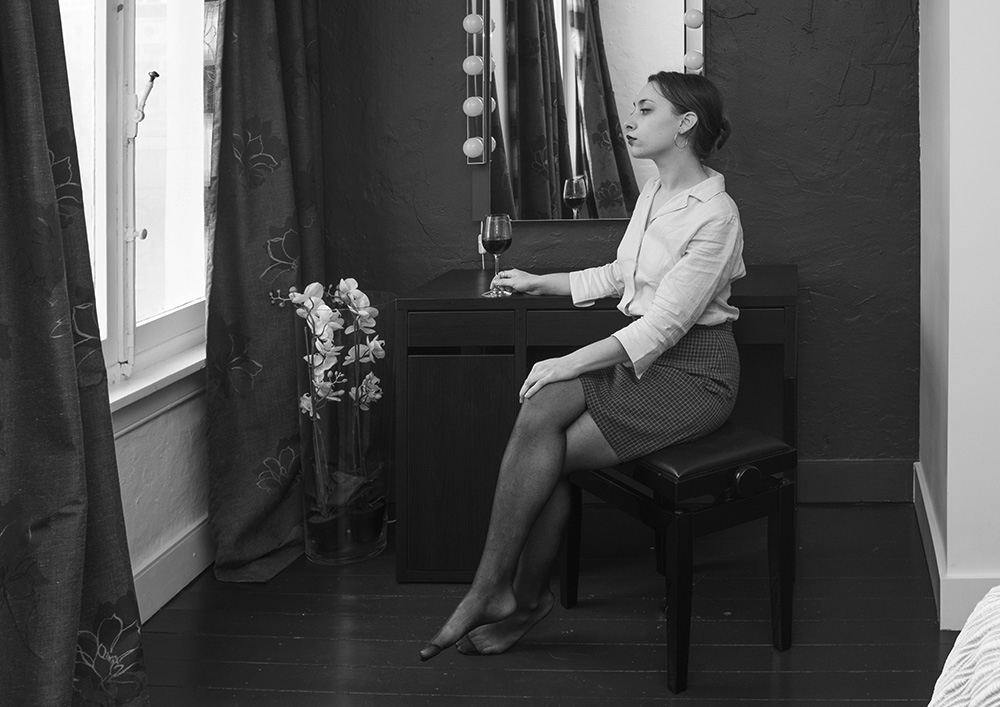
The portrait of me as another character was heavily inspired by the Erwin Olaf Grief series. In this image I humbly tried to construct the character of the upper class widow. It’s a character that speaks to my imagination and is a character that attracts interest. The character stands for grief and melancholy, yet backed up by luxury and class. I choose the ‘boudoir’ as a location for my picture as it can also be associated with luxury. In the pictures of Olaf the window and curtains stand for the idea of discrete solitude. Also in this image I choose for a landscape format to give importance to the interior as part of the portrait.
|
Aron Viszlo
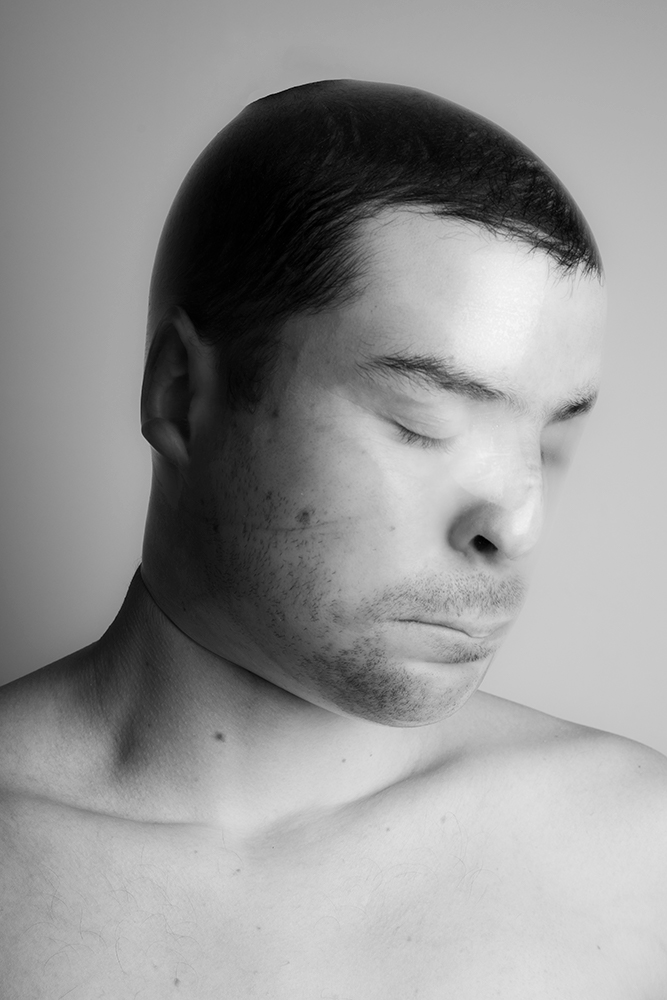
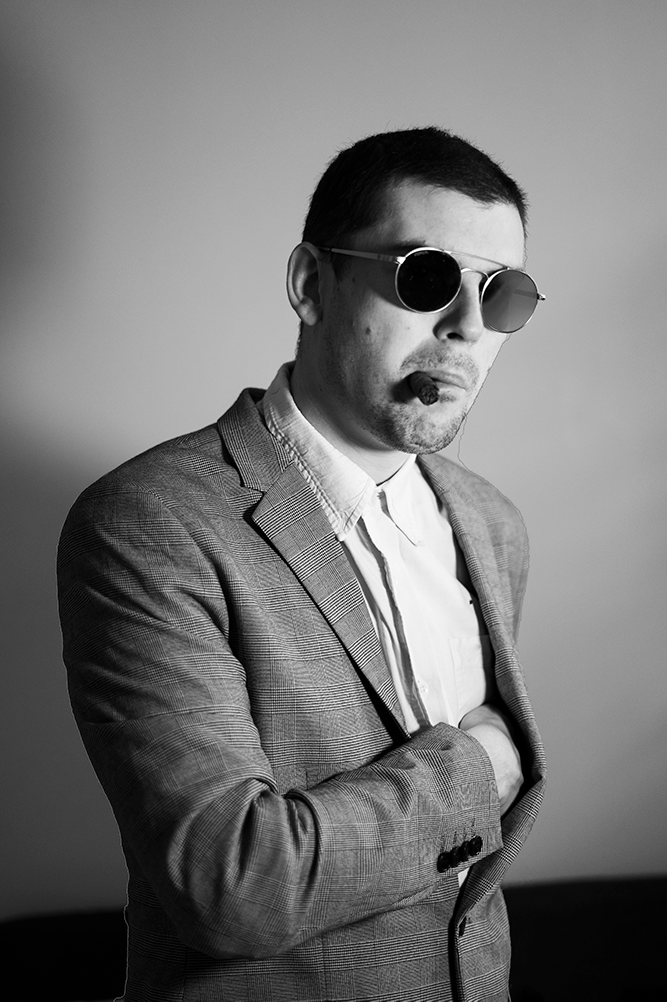
In both pictures I chose a closer frame because I wanted to lock out anything else, just focusing on the individual presence. Same reason why I chose black and white and no set.
Personally, it’s is an extremely challenging time mentally, I just tried to channel that overall claustrophobic feeling. The second picture is about someone whose main line of thought is not about the corona or the current political situation. He is the archetype of the OG. The real ‘shmuck’. The obnoxious person who does what he wants and take what he wants. It is not an appealing character but the freedom what he is represent is enviable
Both pictures were inspired by a movie and more precisely two quotes from the movies:
1. Jusqu'ici tout va bien… (Le Haine, 1994)
2. “One day some of the kids from the neighbourhood carried my mother’s groceries all the way home. You know why? It was out of respect.” (Goodfellas, 1990)
|
Bas Verrept
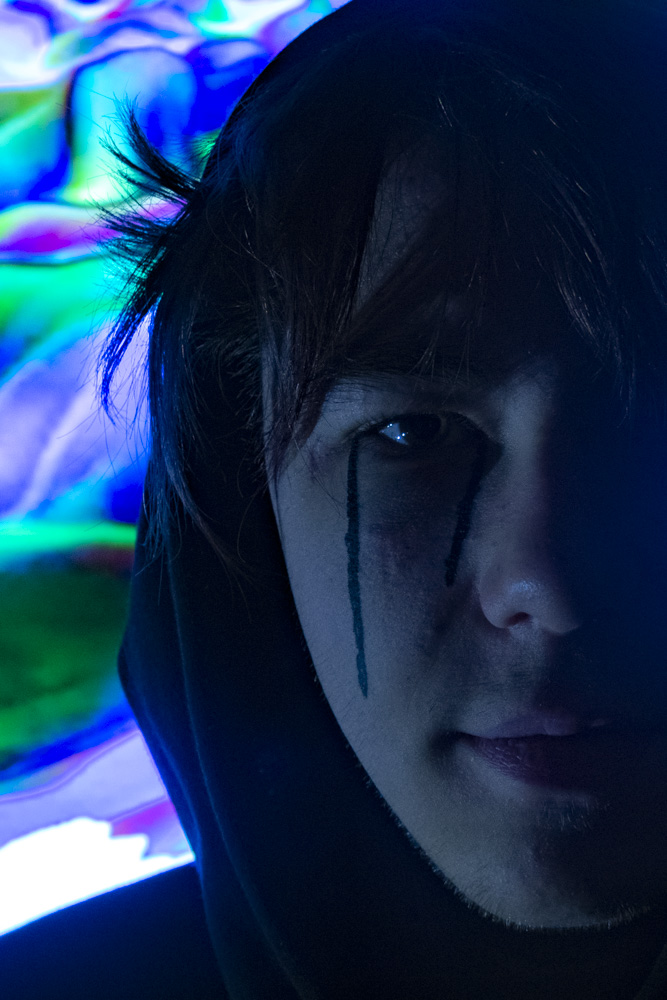
Sometimes I feel like I’m in this happy, trippy, colourful world. I always act happy towards myself and other people but actually I am just bottling up my emotions. After all I’m still a happy person tho. I don’t like making this too personal but I guess I already did. Peace.
I placed myself in my room where I spend a lot of time. I turn on my disco lights and music and sit on my bed, sometimes I dance a little. Once I'm in my room it's hard for me to leave it, even to take pictures. Fortunately I have good friends who push me to photograph outside.
I put my camera on a tripod, the tripod on my bed, the LED lamp on blue, and myself in front of my monitor. It took a while before I had the right frame, my head had to fit in the monitor. The correct facial expression was also difficult to find. The background is from an audio visualizer of Poweramp made by Suksma.
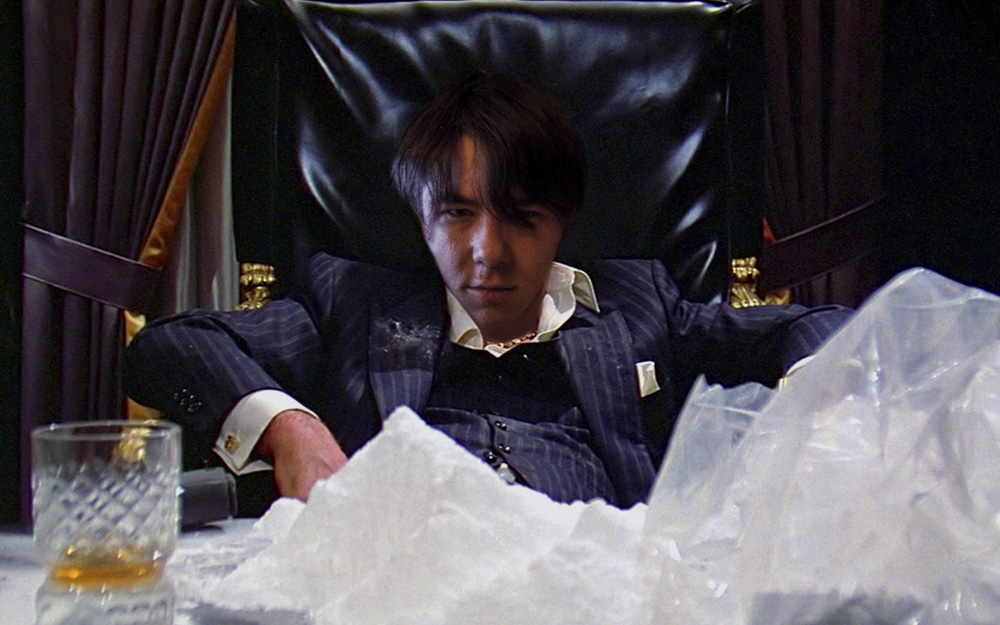
I got inspired by Martin Parr and took the transformation thing very literally. I could have recreated the scene but this is much funnier. I recreated myself as the drug lord Tony Montana from Scarface. He has been through a lot of bad things, I don't want to experience those, but the good things, his career from bottom to top has always appealed to me and therefore I admire him. So I put myself at the top.
I placed myself in Tony's headquarters, with his presidential chair and all his cocaine on his big table. In the movie he looks depressed, his downfall is near. I've turned this around and look proud and determined. The mood of the photo is completely reversed.
I used different lights for the picture and placed them on the spots where I thought light was coming from in the real picture. Then I placed my camera slightly above me and let it look down on me. Most of the work involved post-production to get the contrast, vividness and color balance right.
|
Brent Decraene
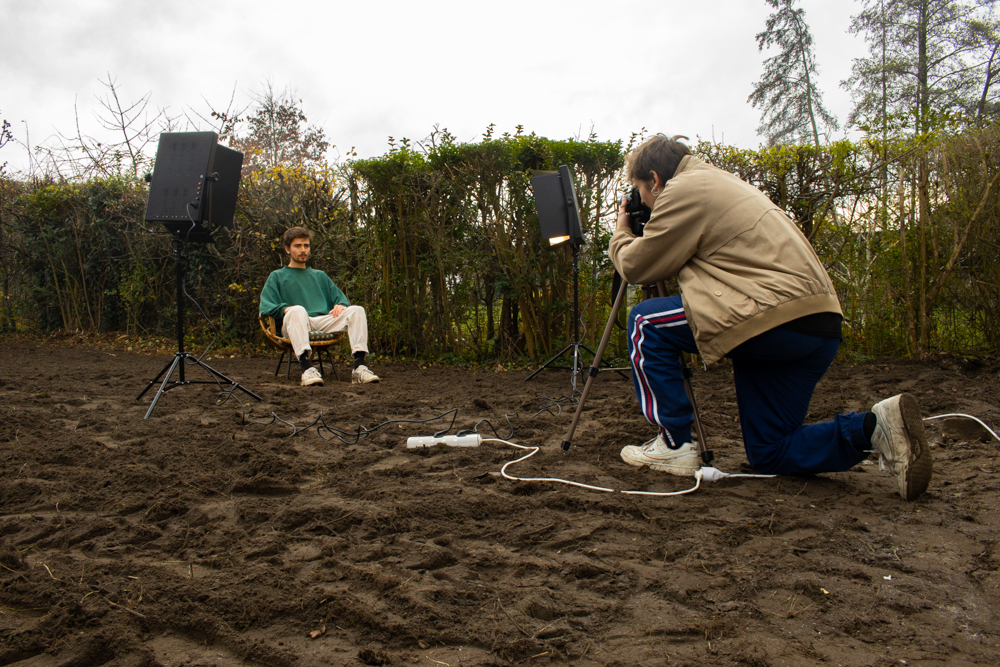
I made a double self portrait where I was the photographer but also the subject.
I setup the studio lights to make it look like a real shoot.
The viewpoint of the camera is both the photographer and the model to get the whole
situation. The photographer focusses on his camera; the model looks straight into that
camera.
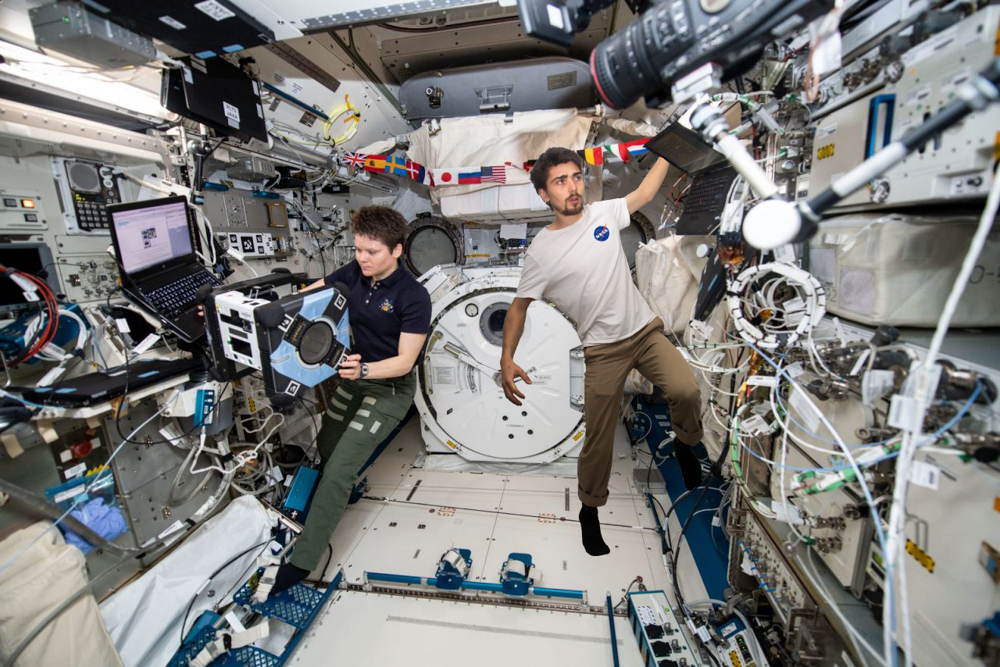
A self portrait of one of my dreams as a kid. I wanted to go to space.
The setting is the ISS where I photoshopped myself into.
I tried to make an as good as possible pose that looks like I’m floating in space.
|
Bruce Bomfim
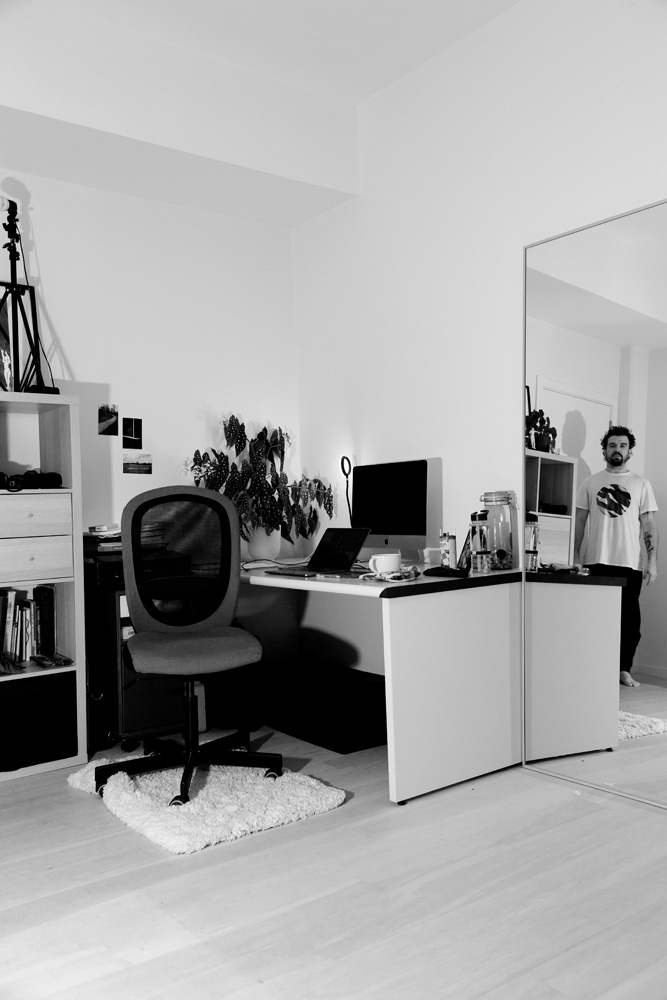
In times of isolation, we have never spent so much time in hour homes. We are somehow confined in this space. For this image I have portrait myself blended in this little corner where I have been spending most of my time. So much so, that it seems at a certain point that there is no separation between me and the space anymore. I am embedded in all those objects and those objects are embedded in me and therefore we start reflecting each other’s presence.
Method - I used for this image a full frame digital camera with a 24 -105mm lens (24mm). I used a speedlight to get everything in the frame lightened and on the same level and also to cast a shadow giving more depth to the scene as a whole.
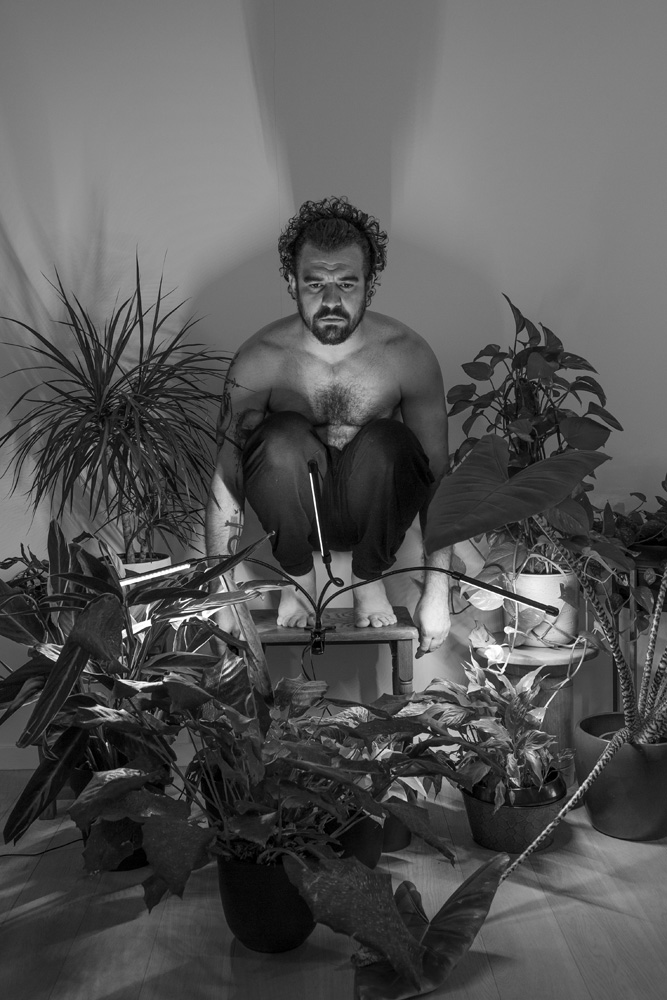
Domestic plants, for some of us, really become something part of our lives. We care about them, we talk to them, we wash them. We try to learn how much water they like, if they are happier in the sun or in the shadow. In some many ways they are beings that express different aspects of the divinity. For this assignment I decided to put myself in the “vase” of a plant and share their space with them.
Method – I used for this image a full frame digital camera with a 24 -105mm lens (50mm) on a tripod. The lighting is the one we normally use to give the plants extra light (another form of caring) when they don’t have much of natural light or sun for a while.
|
Catherine Smet
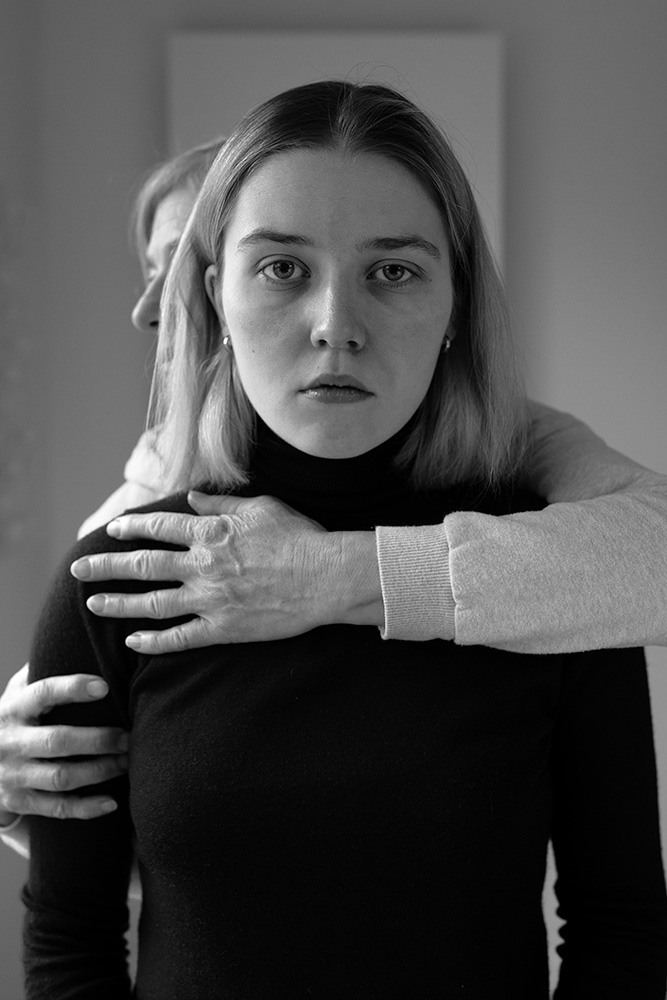
This image is showing the mental state that I'm living in. In these difficult times I'm relying on a support system. That support is my mother. For me this image shows comfort and warmth.
I'm looking straight into the camera to invite the viewer into my world. My mother is not very present in this photo except for her hands that are holding me. I'm using sharpness to make this more clear. The photo is not a portrait of the two of us. It's about the way she makes me feel and the role she plays in my life. I wanted it to be very simply portrayed by an embrace. Something we're all dying to do these days. Hold one another. We're very close to the subjects to make it more intimate. I wanted it to be simple and not
draw any attention away from this gaze and embrace. That's why the image is in black and white. The black turtle neck makes the attention go towards my face and the arms of my
mother. There's a contrast in the clothing. I looked for a place in our home where we could get the best natural light. There is little to no artificial light in this image. Behind the subjects there is a white square. I actually think it gives some sort of satisfying feeling. It's right behind the heads and kind of keeping them together. The ISO is 640, the diaphragm is f3,2 because there is more focus on certain aspects. The shutterspeed is 1/100. The natural light wasn't very bright on this over cast day.
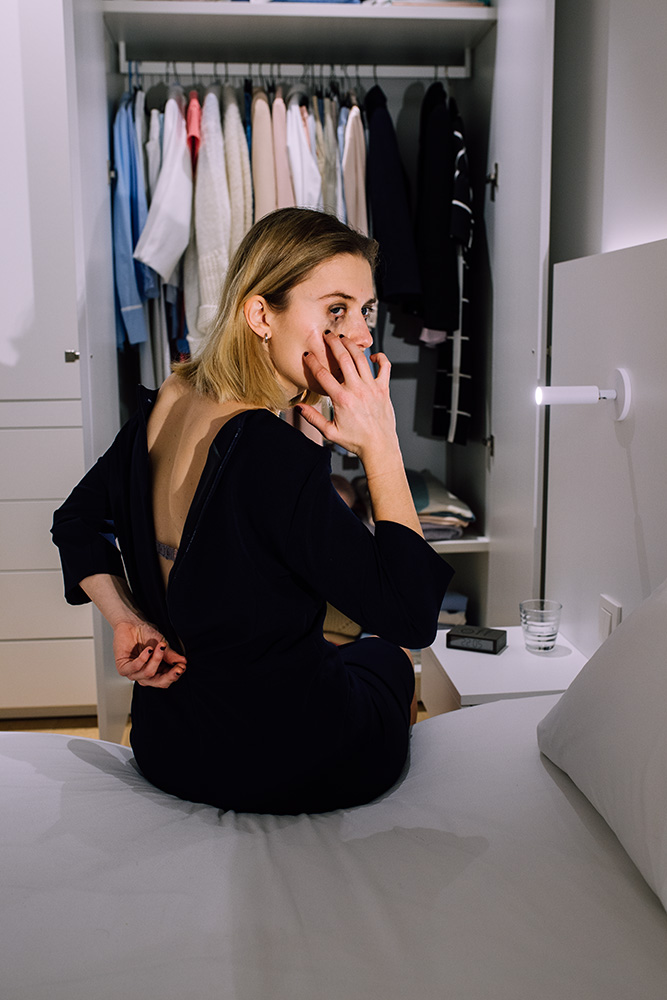
This character is living an empty existence. She is removing her dress which makes up her whole appearance. Her make up is fading. She is sitting on the side of a bed in a very sleek
modern space. The closet shows her possessions which are also meaningless. Somebody has a power over her. That dominant person is shaping her life and she is far from happy living it. In my mind there is somebody outside of the frame towering over her and making her feel small over and over again. That's where here gaze is going. The distance to the subject is showing that we are close to her physically but still we are very far away. Her back is turned and her face is covered. We know just enough to see that something is wrong. We are more of an observant getting a glimpse of her pain. Colour doesn't play a big part in this image. The white space enhances this. I used the light that was present in the room. It is all artificial light. I wanted it to feel cold and distant. The composition is supposed give off an uneasy feeling of being confined in a room. The shutter speed was longer than i wanted but I didn’t want the depth of field to be too shallow because the space is important to understand the character. The ISO is 640 and the diapraghm f4 to get what I just explained. I used a 35 mm lens because I like the feeling of it. I use it a lot because it makes me get close to subjects in general. In this case the camera needs to get close to me. The character is not just sitting still. I wanted there to be some sort of action even if it's in very small gestures such as opening the zipper of the dress and rubbing her faded make off of her face.
|
Daria Oprean
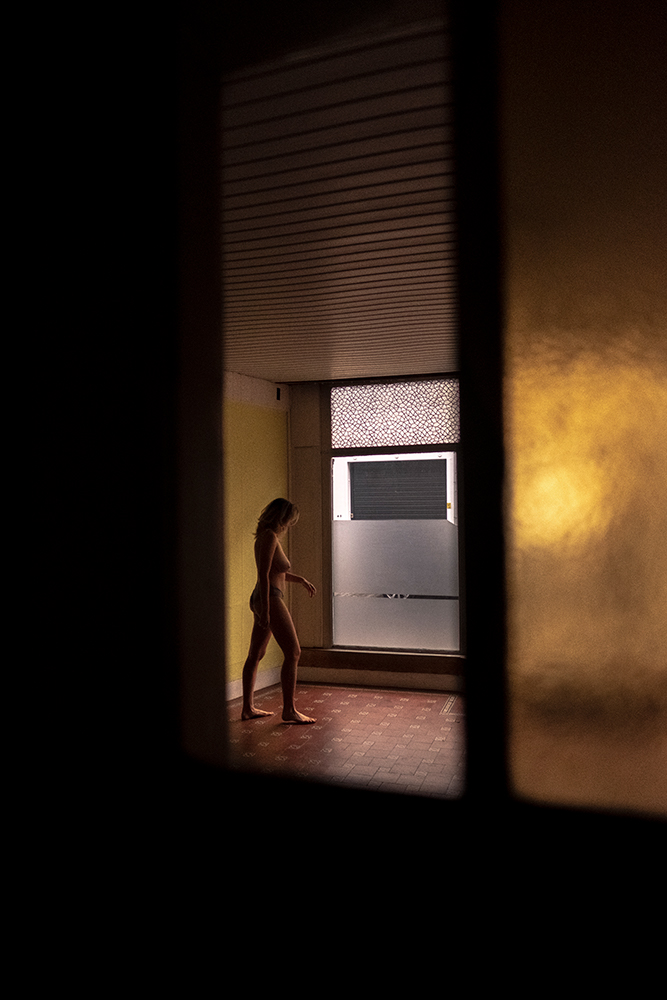
I’ve been feeling the effects of the lockdown more so this time around, then in March. I no longer feel like I see the advantages of the lockdown in my life such as more time, focus on myself etc. And I’ve been starting to feel like a zoo animal walking from one side of my cage to the other and back. I wanted to portray this feeling in my self portrait, because I can’t seem to find my place in the world anymore, or even in my own life. I decided to take the picture through a broken glass in a door frame, to emphasise to the viewer the feeling of observing someone in captivity. The same role has the window in the background of the picture. It stresses the fact that I am being viewed from different points, by different people. I
placed myself in the corner of the room to accentuate the feeling of being bound to one place at all times. I decided to opt for a pose that resembles the last human drawn for Darwin’s theory of evolution, to illustrate my perception on my own evolution, which has stopped.
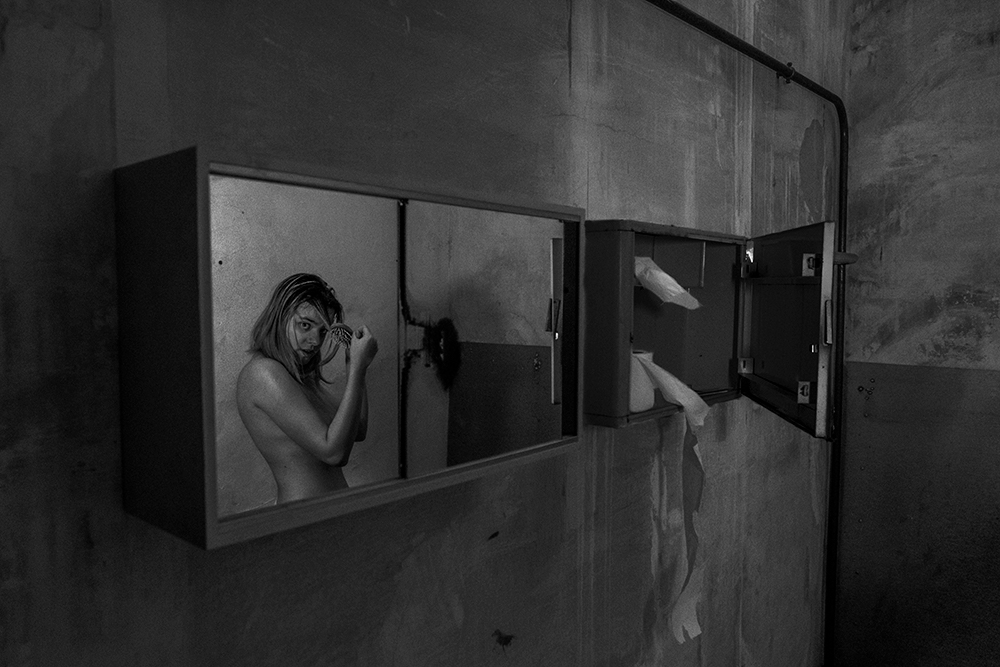
I was inspired by the patients of a Romanian hospital that were let to roam around free, unsupervised, and untaken care of. I decided to take the picture with a 16mm lens, to disclose
the context and location of the image, but also, due to the fact that I photograph a corner of the room, to get the feeling of symbolical dead end. I opened up the metal drawer and placed
wrapped toilet paper in it, to inseminate an idea of fragility, and vulnerability, especially in contrast to the gaze of the subject. I decided to pretend to comb my hair, in order to show the subtle act of desperation to feel intimacy and care, from a highly dissociated patient. I chose to look directly into the camera in a confrontational manner, while also pushing my face inwards, to contradict my view. The image deteriorates from left to right. Striating from the darkness that gradually changes into light, from a blank wall that becomes patched, from a combative pose, to the kindness of the hairbrush and the fragility of the tissue. The deterioration stresses the decline of the psyche of the subject.
|
Daria Yashina
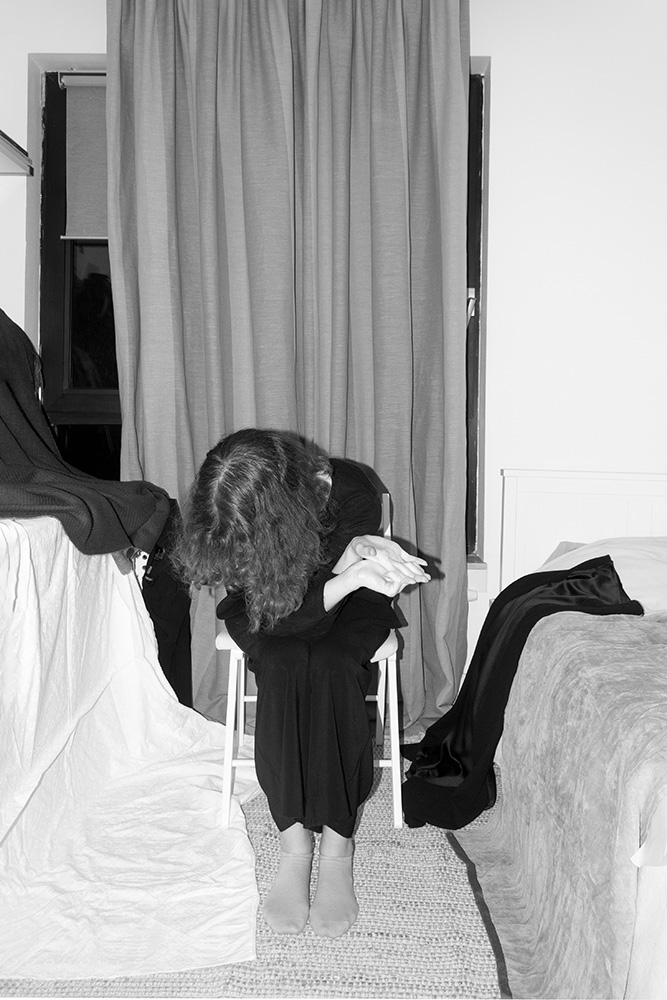
The photograph depicts a psychological state of emptiness and apathy; feeling of being drawn to the ground and unable of experiencing emotions in depth.
My room is the most suitable place to describe this state, as it is connected to daily patterns and disturbing neutrality of being.
The distance I took as a photographer makes my own figure a bit lost in the environment but still visible. The fabric of my clothes resonates with fabrics in the space around, which covers almost all of the surface, leaving small gaps in some places. Covered space describes impossibility to react and to see a phenomena in it’s own depth and complexity, and the small gaps are made as complete ‘coverage’ is not possible. A possibility to react is always present, at least in the form of ‘tiny gaps’. I used the flash light as it flattens the image, cutting out the volume, and the volume shaped by light, on the contrary, is what reminds us of being alive. My pose expresses again the feeling of being ‘covered’, and the gesture of hands is about being in struggle within this state, trying to overcome yourself.
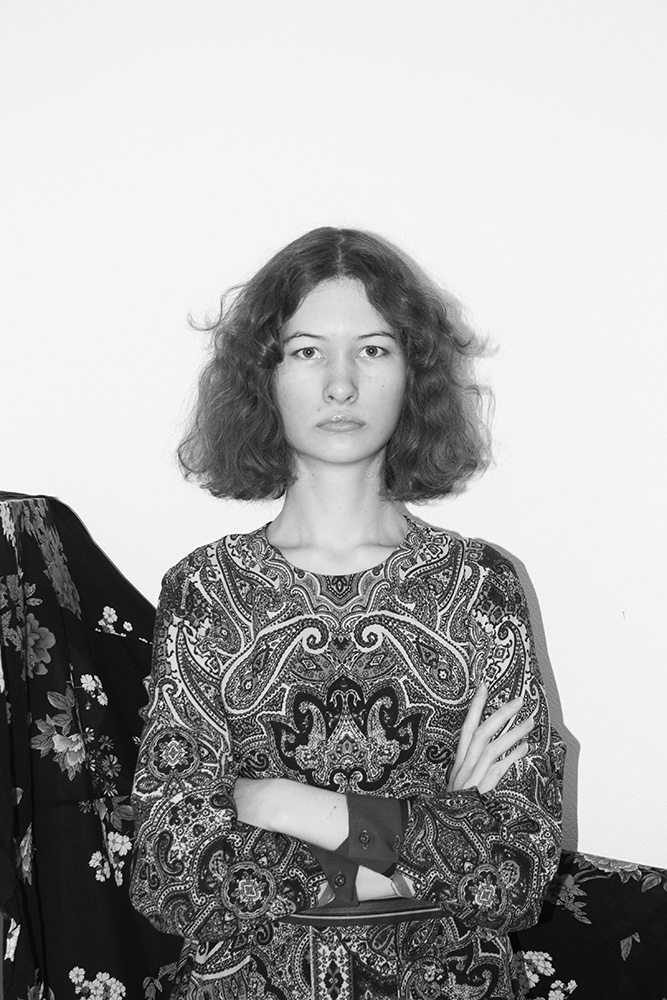
I tried to turn into my mother. Being more precise, I wanted to depict more how I see her and how she appears in our relationship.
For the background I combined contrasting fabrics with flower pattern and plain white wall in order to express the main contradiction of her personality: a desire for brightness and liveliness and predisposition to rationality and practicality in every detail.
The distance I took as a photographer makes the figure appear straight-forward, without giving a choice, which describes for me the straight-forwardness of the person and a will to be visible. I used clothes and make up which she wears and which, In my opinion, can be associated with her. Flash light plays a role opposite to the previous image: it makes a figure appear in the most convincing way. The second reason is the static, frozen image of my mother in my head, it barely changes over the years. The pose expresses a particular look and gaze which reminds me of her the most and also most suitable to describe the complexity of our relationship.
|
Diane Mondésir
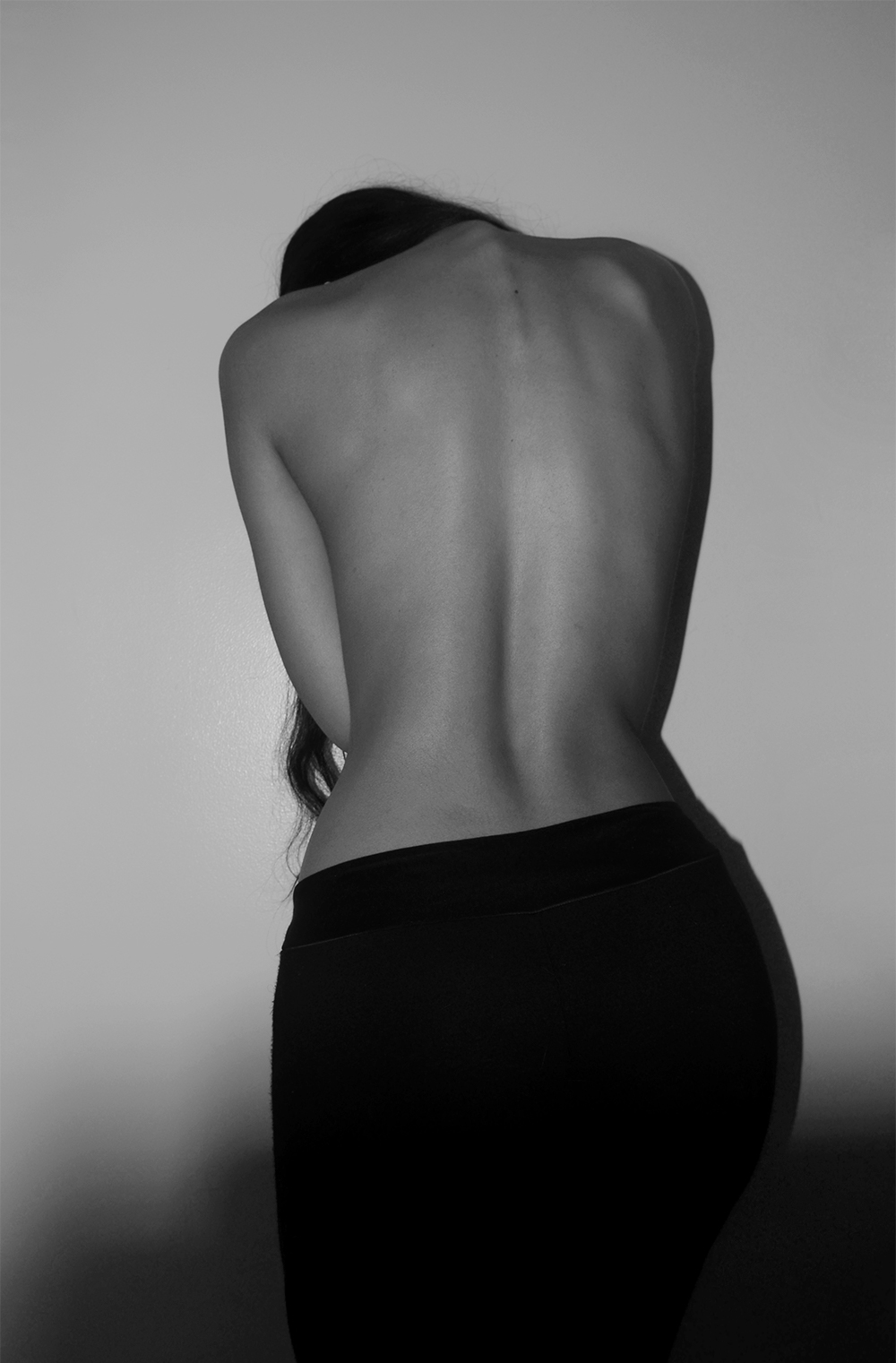
Being very sensitive to the dynamic and the power of the body, I placed myself with my back turned to the camera. I used a self-timer to prepare my pose and chose to have
my back curved in order to reveal my vertebral column. I think the vertebral column defines a part of who we are in a way that it supports the body's weight, our weight, our past and experiences, our trauma or happiness. It is the center of our body and without it the body collapses. It also grows in us as if it accompanies us until our death. The sober white wall accentuates the sculptural look my body revealed. The choice of using black and white adds contrast and allows the viewer to focus on my back.
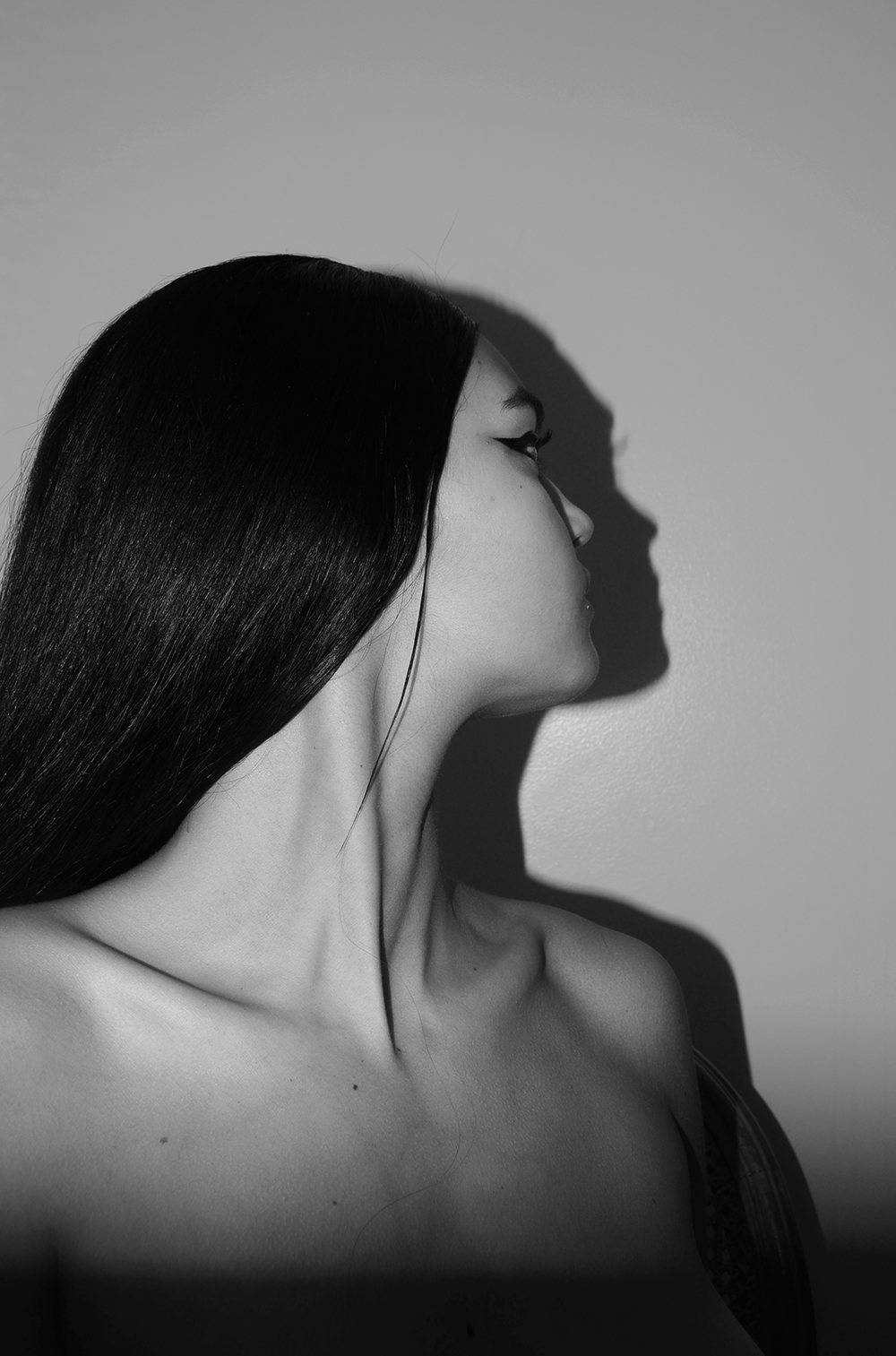
I photographed myself not revealing my face but revealing some details of my bust. Using flash and being closer to the camera allows the viewer to analyse the shapes and textures of my skin, hair and bones. The shadow creates mystery and enigma of who I am.
|
Dimitris Siokis
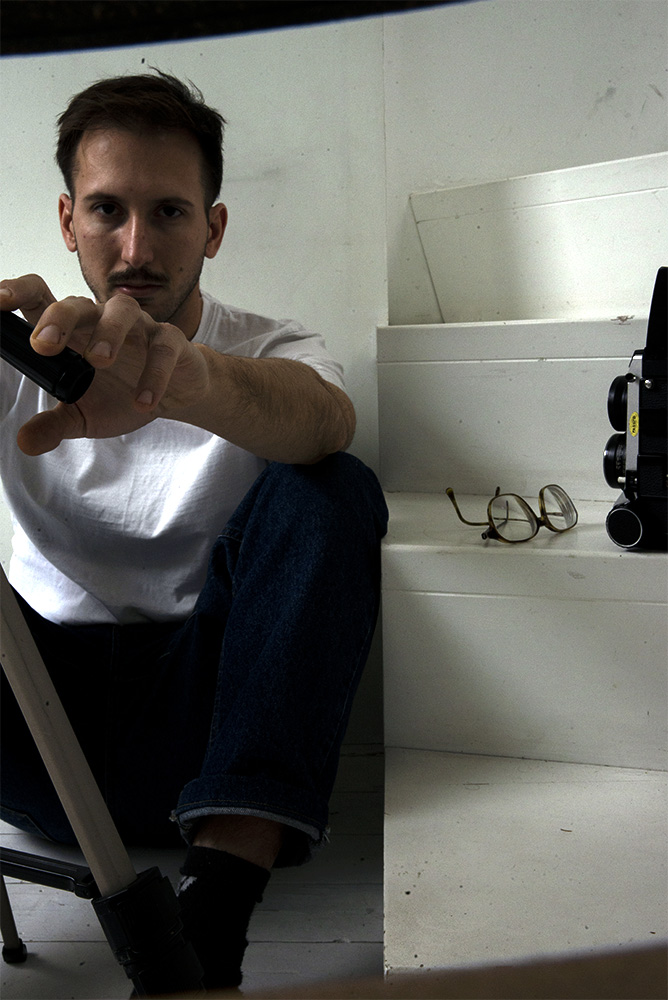
This self portrait is about a moment of self-realization in my current context. The space is that of my room and I am sitting on the floor next to the staircase. I use only the natural light coming from the window and the camera is placed close to me with a 50mm lens (same as the fixed one on my first camera). I am surrounded by some photography equipment (tripod/ 6x6 camera) - an indication of my immersion in the photography world during the last months. My glasses are also placed next to the camera, as an item that I rarely use when with other people but also as a hint in how reality is transformed through a lens, questioning even this very self-portrait. The camera that is actually making the picture is placed on a chair, creating the frames on the top and the bottom of the image.
Technical aspects: shutter speed 1/8 sec, f22, iso1000, 24-70mm lens set on 50mm
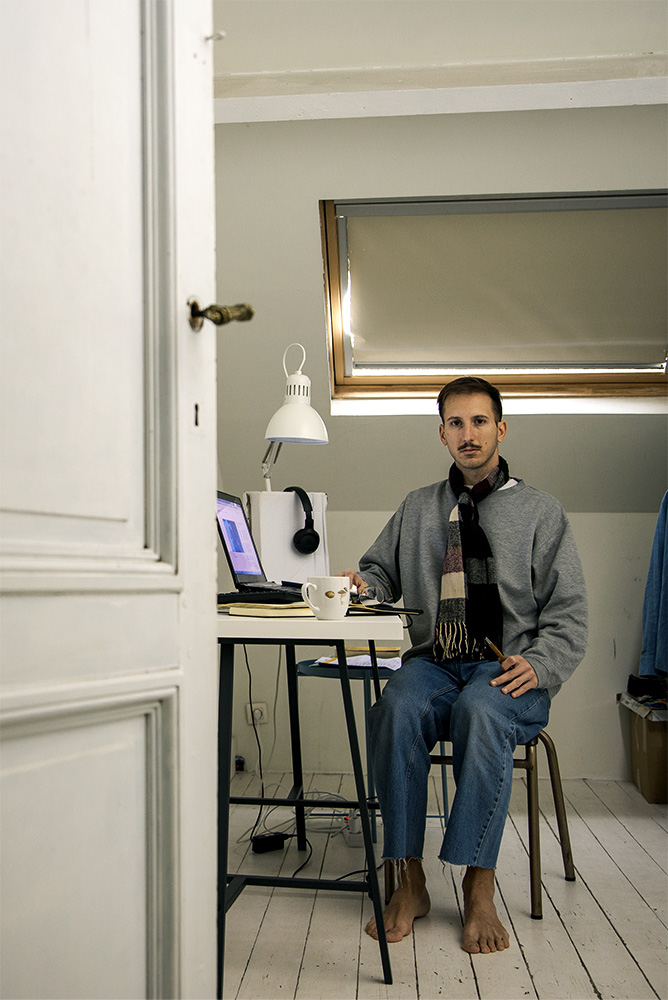
This portrait is of my roomate, who is a software engineer and he spends most of his time in his room (right next to mine) working on his computer, with his window shut. He usually wears a scarf and walks barefoot in the house. I placed the camera outside the room, as it is a place that I rarely enter and the view I have of him is through a half closed door most of the times.
Technical aspects: shutter speed 1/13 sec, f2.8, iso800, 24-70mm lens set on 24mm
|
Ean Demaeyer
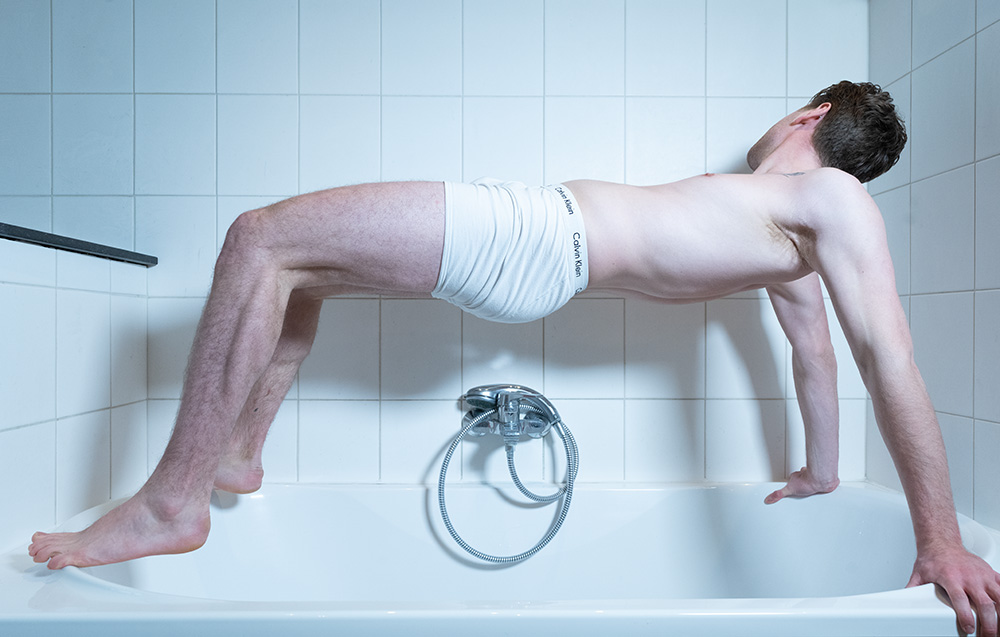
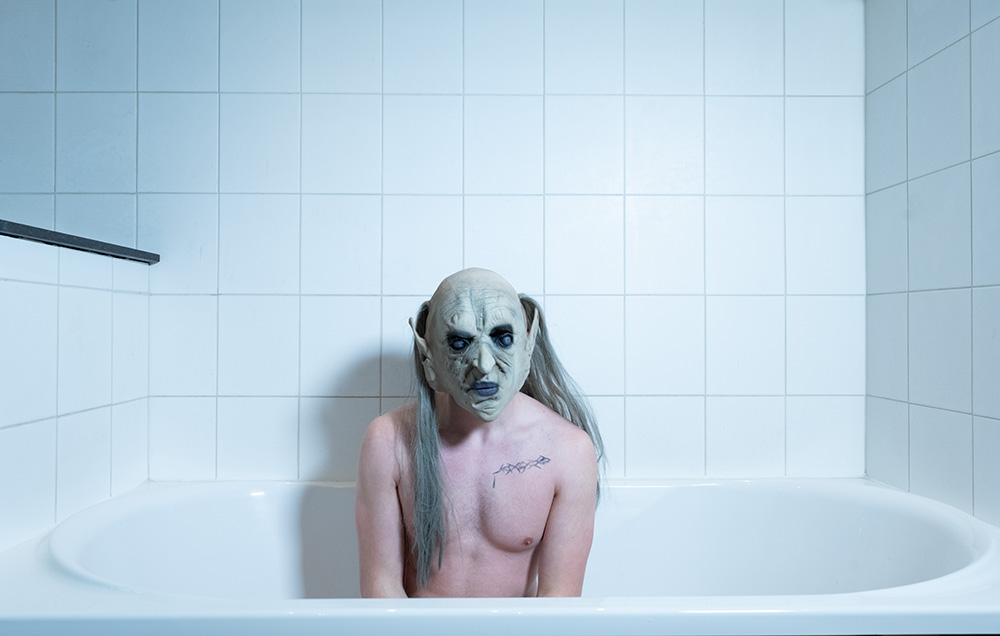
In both self portraits my white tiled bathroom is a representation of the withe, isolated box I’m living in most of my days. I used a white studiolight to lit my body and my surrounding to recreate a stimulus-free space. The ones they use in a psychiatry, I had in mind.
I made it a little bit more blue in postproduction, to give it a cold atmosphere.
it's about resistance and surrender.
|
Eduard Michalko
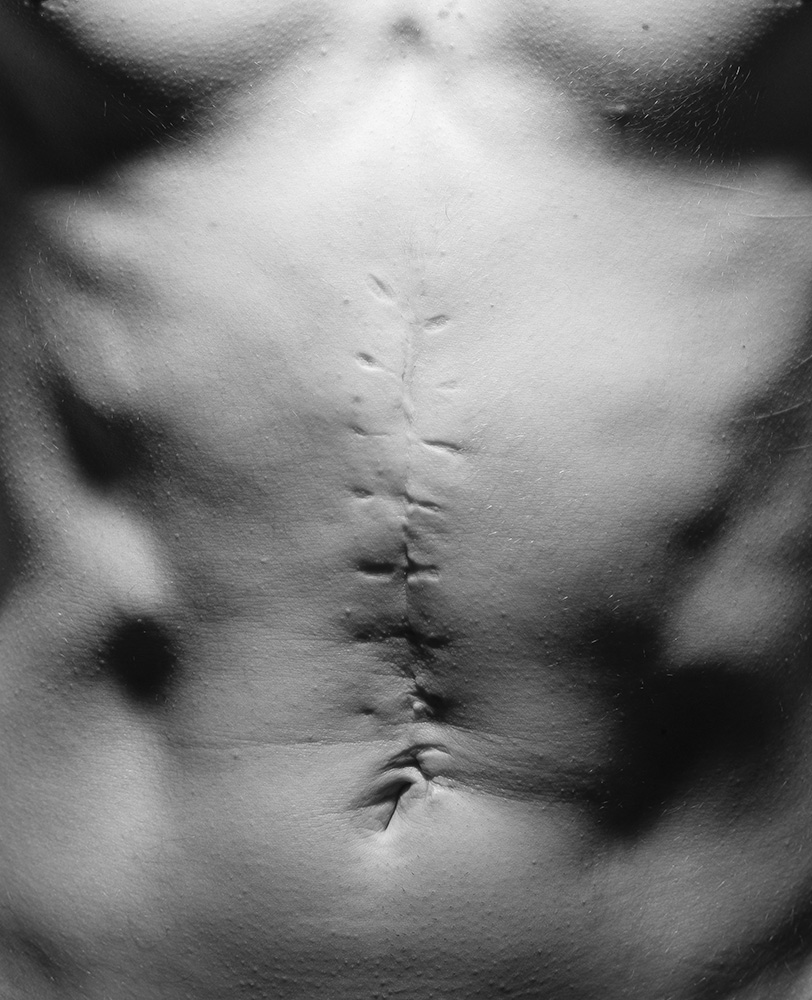
Everyday self- portrait from my birth
The first photo of me was taken with a flash that was by my side

After watching the film Sundays and Cybelle, I tried to put in the role of an actor, where the footage shows fragments of the film in which I play.
The second photo was taken with a selftimer on the camera and a white background
behind my back, I used a tripod and the timer was set every 10sec one photo
|
Esmeralda Janson
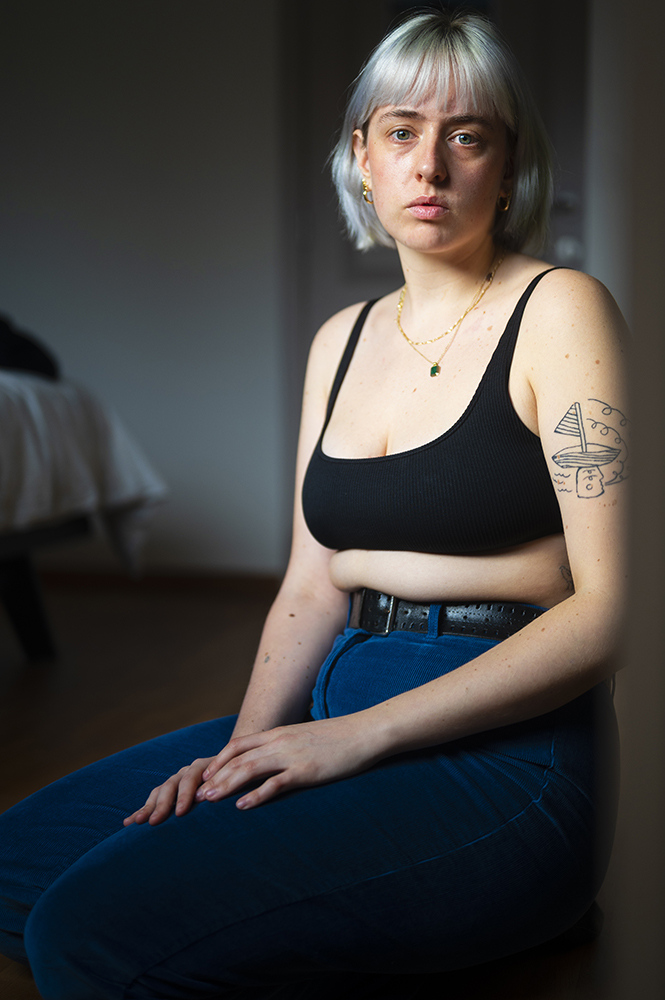
With my first portrait I took the question ‘to be as honest to yourself’ very seriously. I have been dealing with eating disorder and body related problems for years. They are a big part of who I am and how I look at myself and the world today. While I’m definitely healing from those, the fat I have on my stomach still scares me. And sharing this is so openly is about as honest as I could be. I used a low diafragma to get a very soft focus for a more intimate feeling, and only used natural light. For the frame I used a mirror, this felt the most realistic to the feeling I wanted to get across.
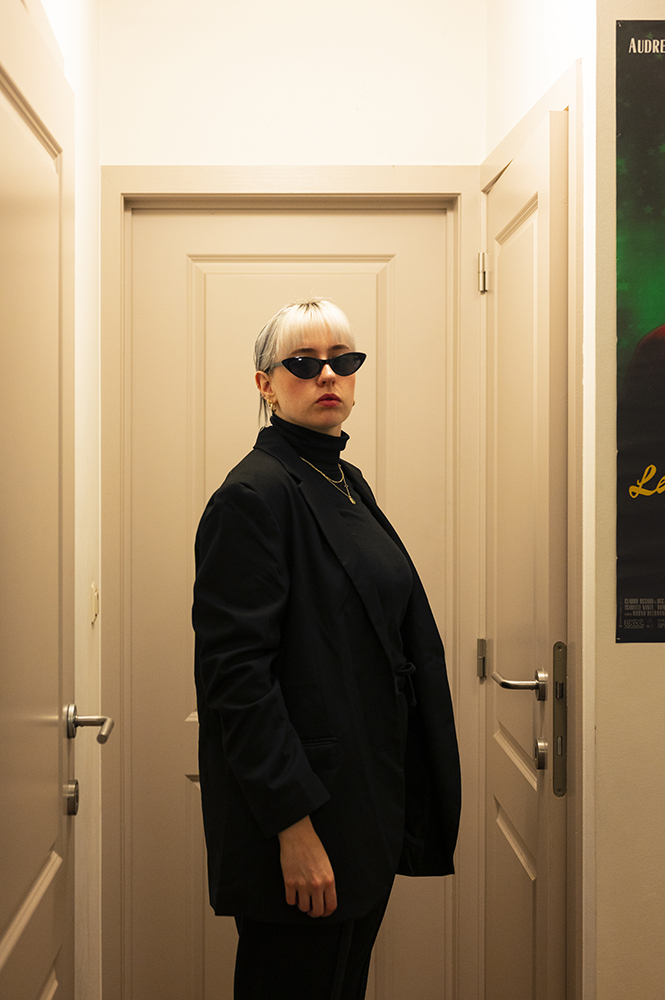
For my second portrait. I went to the opposite site I used black clothing and sunglasses, which work as kind of an armer hiding the softer side of me. With this I didn’t use any natural light, to create even more of a distant and harder character. The closed doors and cut of poster also symbolize how distant this person is and how little they’ll actually show off themselves.
|
Eva Thurman
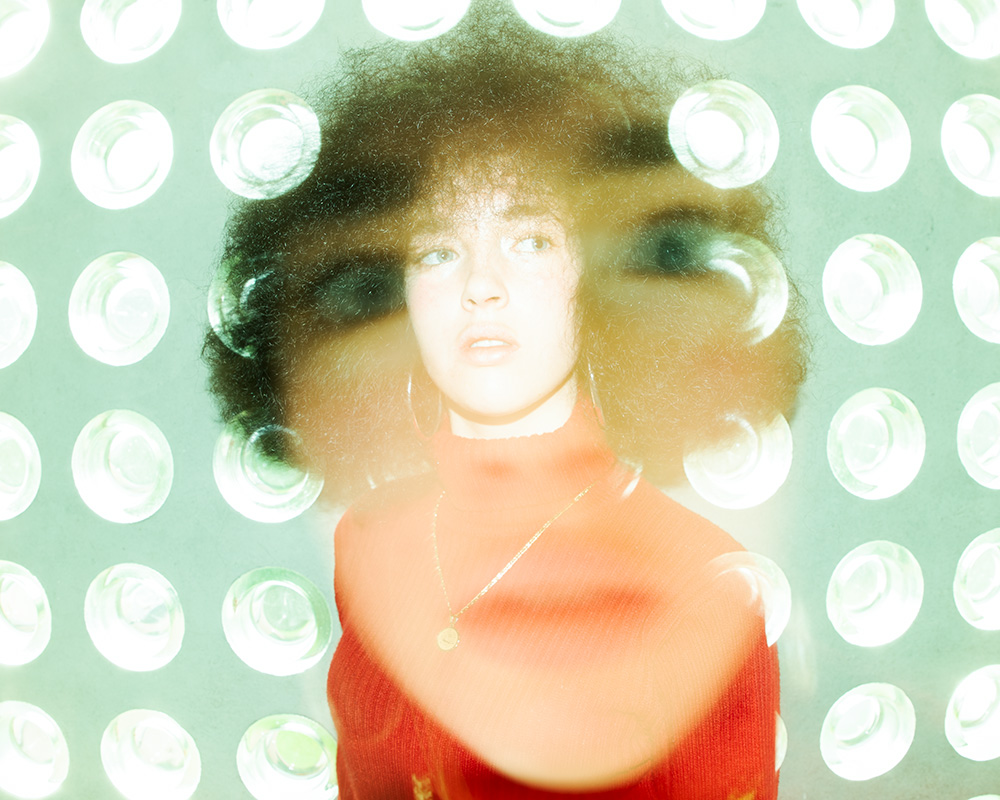
I was searching for a location which could represent the visual circle of the chaotic feelings I’m having for the past couple of months. I feel very disorientated and a little bit out of control.
I gave expression to this feelings by blowing up my own hair and using a shutter speed of 6 sec. Trough the long exposure I was able to show myself a second time in my own portrait.
This reflects the craziness and chaos of the thoughts in my head, but also the jumble of ideas crossing my mind.
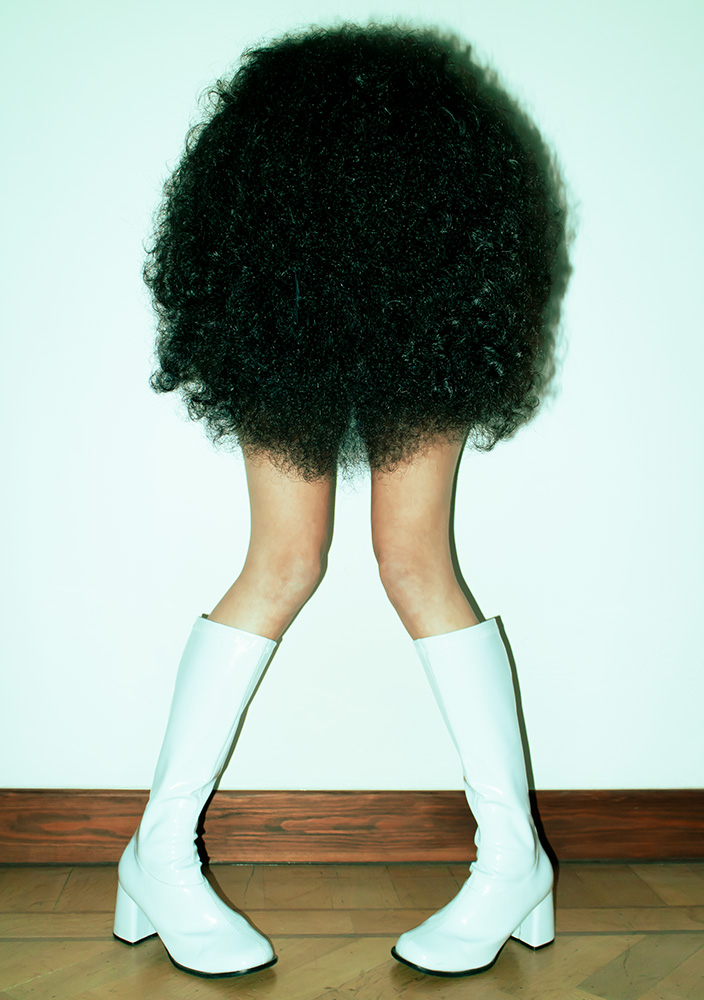
This is a person I do not like very much. The picture shows a head which means reason, but there is no body. So she thinks a lot, reflects, takes into consideration and balances the pros and cons.
The absence of the body stands for the lack of emotion, the insensitivity and indifference for the environment, which is also the reason why I used a white, clean background.
In spite of all her thoughts and reasoning, she doesn’t act. She does not carry out the decisions of her considerations, she has a passive character. That’s why I didn’t gave her arms and hands.
Her legs indicates that she wants to move forward but she does that in a very hesitating way, represented by the wavering position of her feet.
|
Iris Maselis
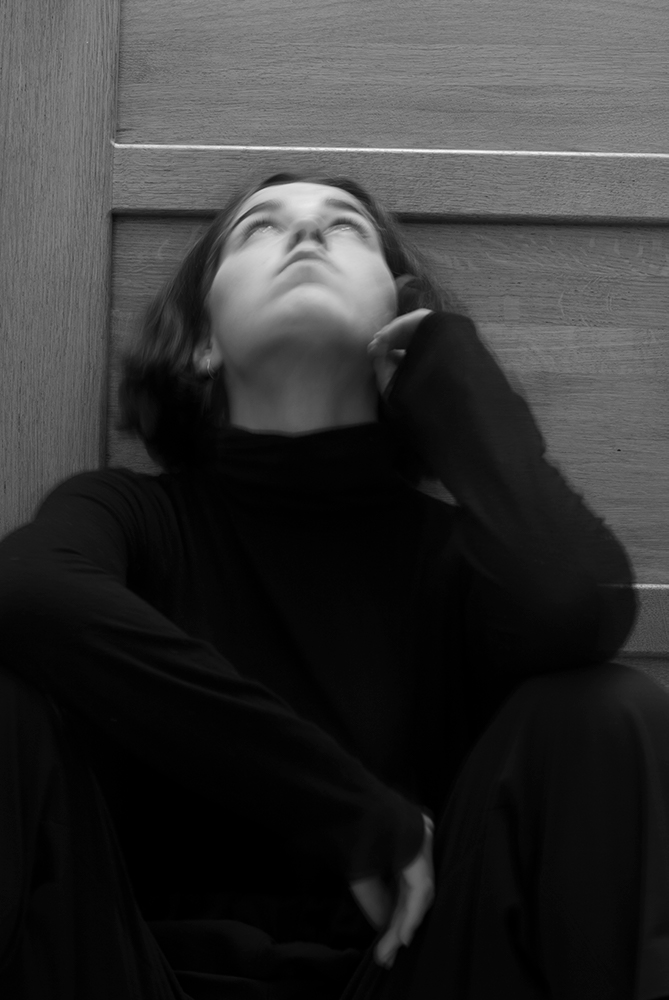
Deze psychologie toont een sfeer van onwetendheid, beknelling. Echter is er ook een uitkijk, een zoektocht, een denkspel gaande. Dit beeld handelt over mijn persoonlijke struikelblok om juiste keuzes te maken. Ik plaats mezelf hier in een strak frame waar een persoon uit wil geraken. Dit kader wordt benadrukt door de scherpte die het toont in tegenstelling tot de onscherpte in het lichaam zelf. Het licht valt neerwaarts, maar als men niet de moeite doet om opwaarts te kijken, blijft men in deze gedwongen kader zitten.
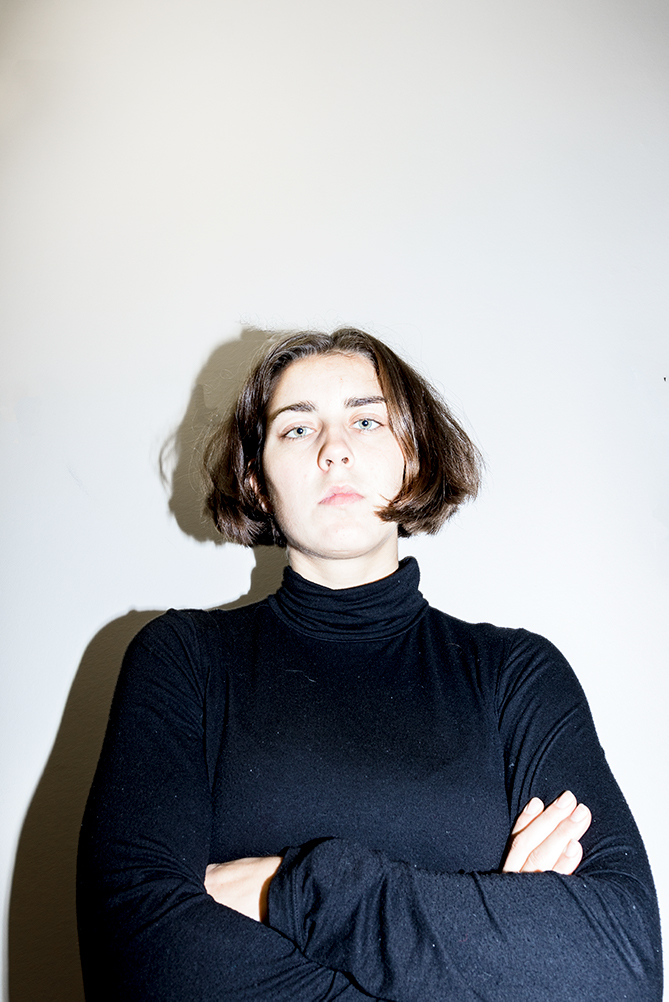
Dit beeld toont de ander, een persoon die ik niet ben maar ook niet wil zijn. Een persoon die neerkijkt en hier ook meteen neerkijkt op de camera. De witte, lege achtergrond met donkere schaduwpartij door een harde flits benadrukt de minachtende blik. De armen zijn gekruist waardoor een conversatie met deze koude gesloten persoon niet mogelijk lijkt.
|
Katinka Meyers
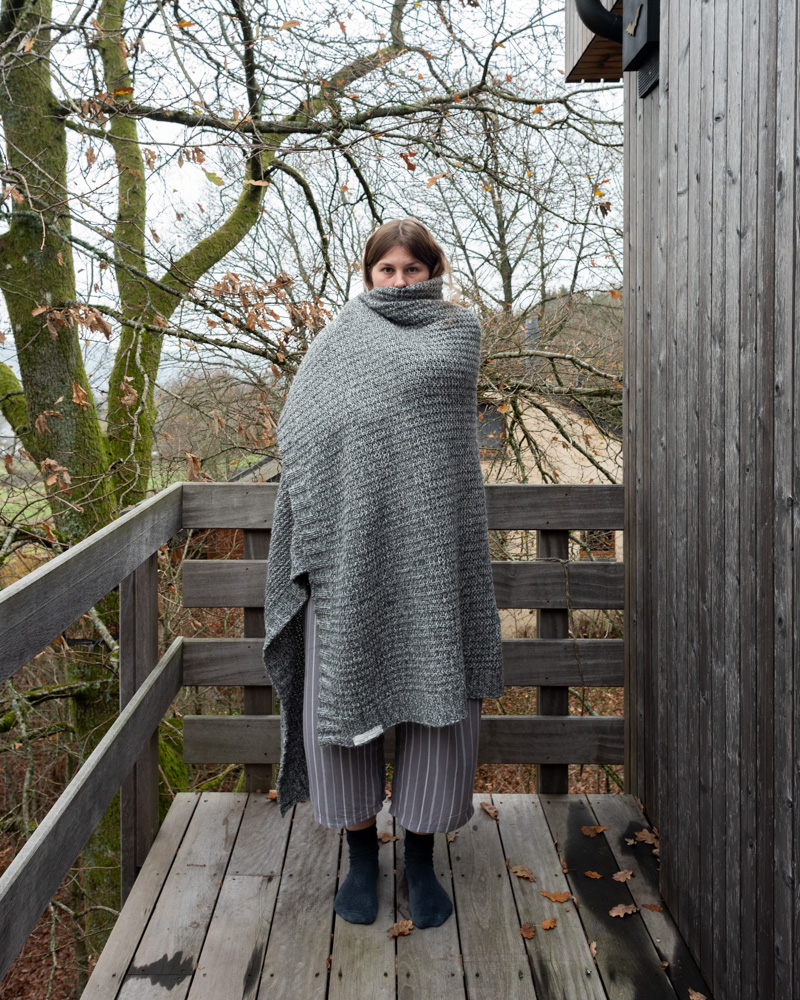
This morning i got my period. This means one day every fucking month i feel like a miserable piece of shit. My body and my mind feel confused. What I want to do most is stay inside and watch series all day. But for this assignment I tried to at least take a moment to breath the fresh air. It was an accomplishment.
I chose to go outside and placed myself in a surrounding with lots of things in the background and foreground. To create the chaos that's in my body and mind.
I chose to leave it in color because it already didn’t have this vibrant colours and the grey of my ‘outfit’ also gives a boring effect. I placed my camera on a tripod and used a 24 mm lens to create a distance. I wanted to show my whole body to make it more uncomfortable.
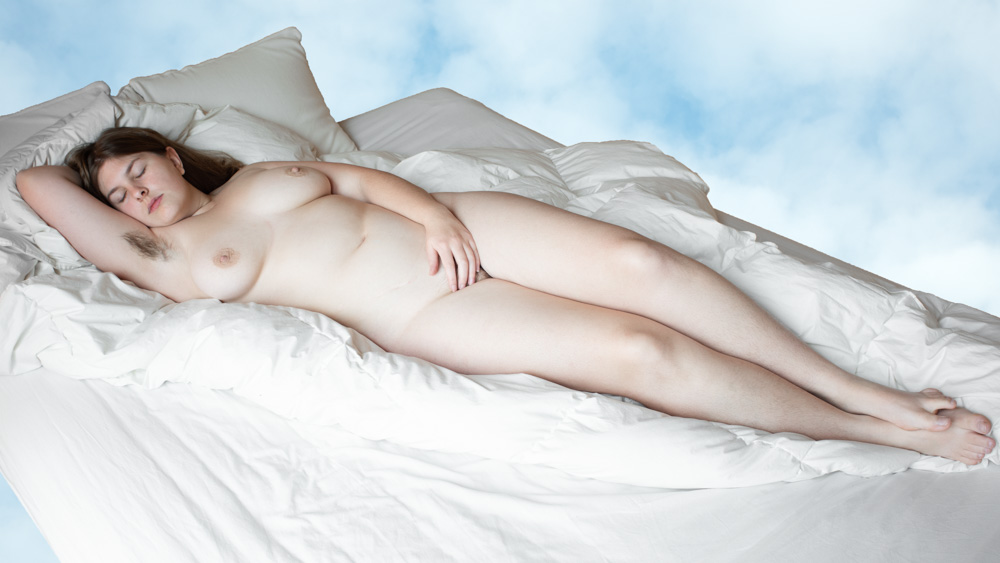
Sometimes I find myself dreaming about the lifestyle of the rich women in the 15th century. They seem so harmonious in their head and have a very fatigued appearance. I’m wondering what they are thinking or even are they thinking? What are their worries about life, about themselves? I chose a bedroom because it gives an extra feel of comfort to the picture. Most of the time they, women of that century, are placed on a bed, sofa or something comfortable. So I placed myself on my bed laying on the white blanket(dons). I chose to take the sheets off because I wanted the white of the blanket to almost feel like a ‘pure’ element. The picture of the sky I added in photoshop adds this serene element.
I wanted to have a serene and beautiful background but couldn’t find or create it in real life so I photoshopped it with another image out of my archive so it would have the feeling that I was floating in the sky. I took the photo with a tripod and a 24mm lens because the room was quite small. I used daylight to match it with the archive picture of the clouds. In Photoshop I also removed pimples, scars and birthmarks to show my body as pure and clean as possible.
|
Milana Starklova
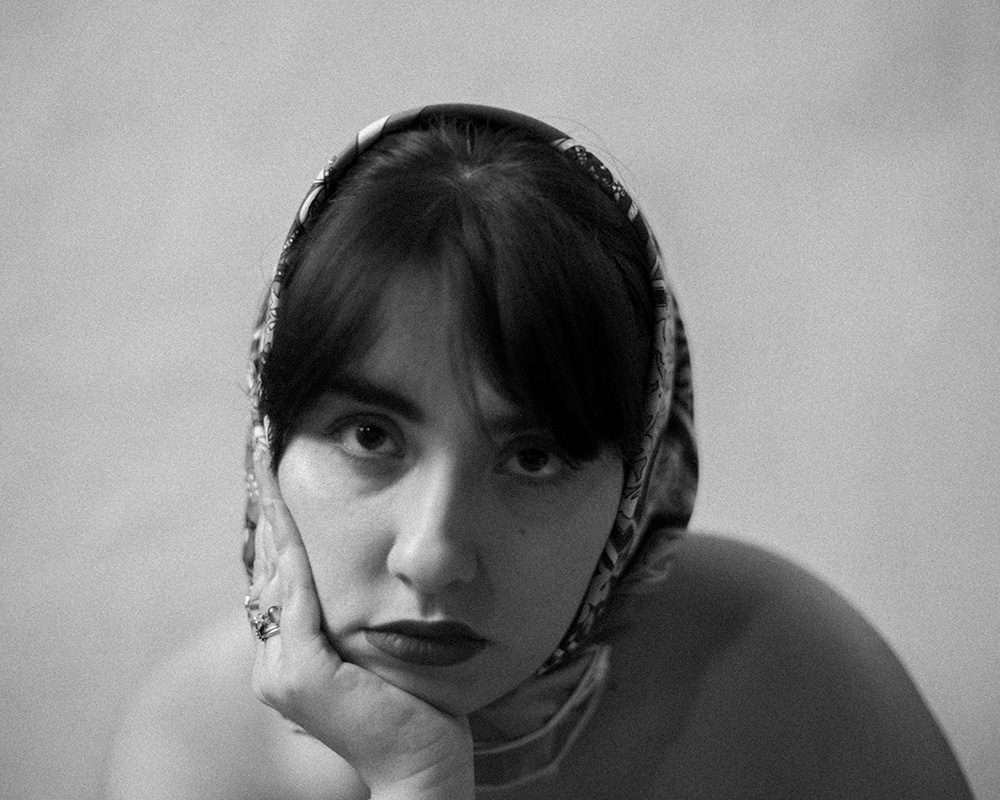
For the past few months I immersed deeper in my culture to work more closely on my autonomous project. It varied from ex-soviet movies to books to just viewing old photo
albums, the sense of longing and belonging. It appeared to me pretty vividly sometime ago that when I’m mentally on my lowest point I tend to submerge myself in music, movies and tv shows from my home countries as if they are the only thing left that still makes sense at this point. I don’t look typically Eastern European or Central Asian, I created my own look from using those two regions trying to reconnect with my roots.
Method: Tripod and a 10 second timer. f/1.8 with an 1/40 shutter speed. Natural light.
The unsharpness and grain places a border between me and the viewer.
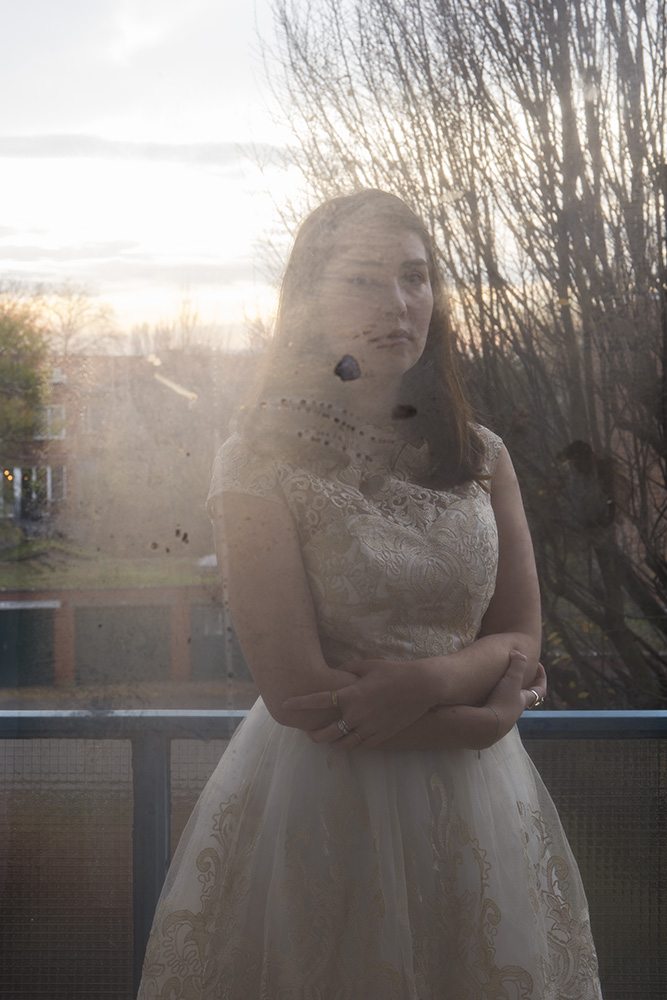
“Man has since the Enlightenment dealt with things he should have ignored.” Tarkovsky. Sleep deprived and lifeless could be a psychological description for most of us. Gone are the
stress-free days of childhood. While the whole world suffers trough a crisis the “capitalist machine” keeps working. More work, more money less mental health. I took this picture as a
past self, someone completely different, with my prom dress worn in 2016. The feeling of accomplishments and new beginnings “a new dawn”. Nonetheless the present time feels like
some unfortunate smudges on the glass.
Method: With a tripod and help of my sister who pressed the button. It was quite dark, and I wanted some detail, so I used f/10 with an 1/40 shutter speed. I used the balcony of my
mother’s apartment as a scene that I remember playing out on prom night.
|
Moritz Broszat
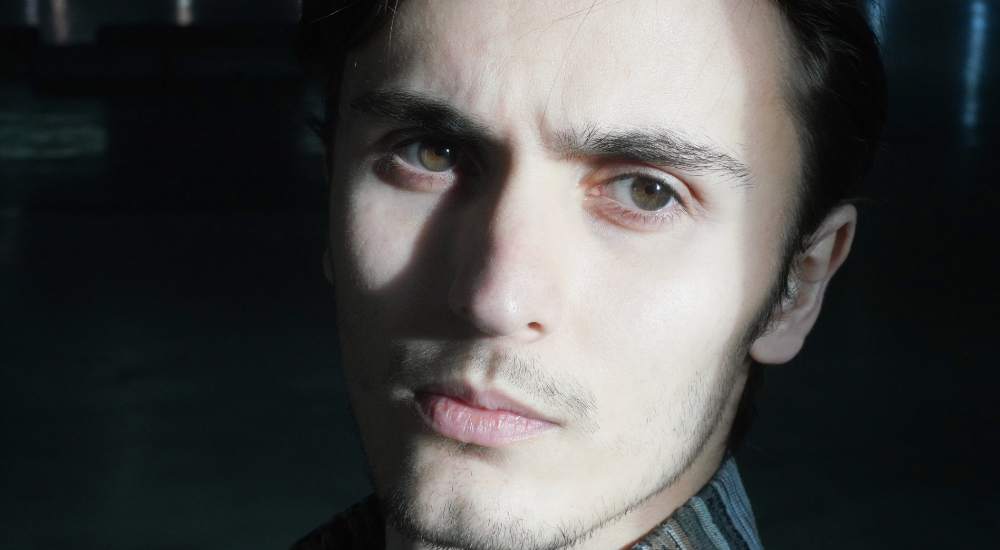
The self-portrait focuses on the expressive mediation of my minds state. It’s emphasize on the contemplative gaze towards the light-source directs me to the feel of uncertainness but also faith.
I chose an empty space as a clear but dark surrounding attributing to isolation and its psychological consequences.
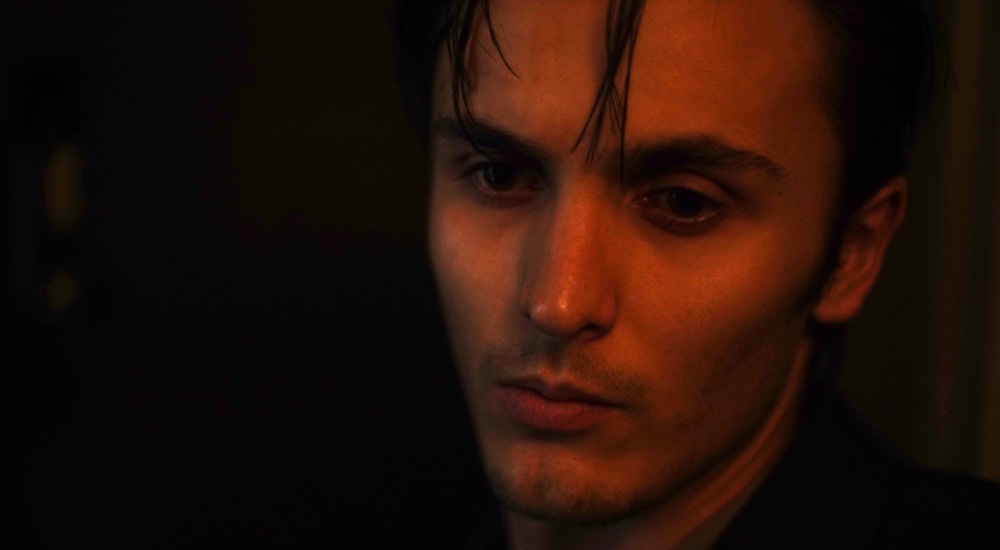
The portrait of somebody else is based on the idea of creating a character that suggests the corresponding characteristics in terms of a cinematic context. The facial expression indicates curtain frustration that is stressed by the dark atmosphere. The images are about building up a sensation that is lead by the use of light and the just the facial expression photographed as closeup.
|
Odelya Atlasovitch
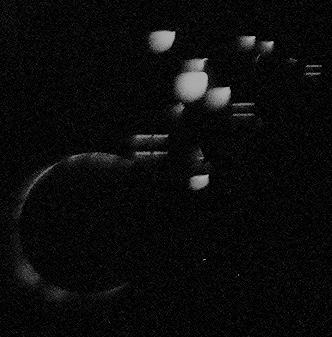
Odelia Atlasovitch’s Inner Light in the last days of 2020
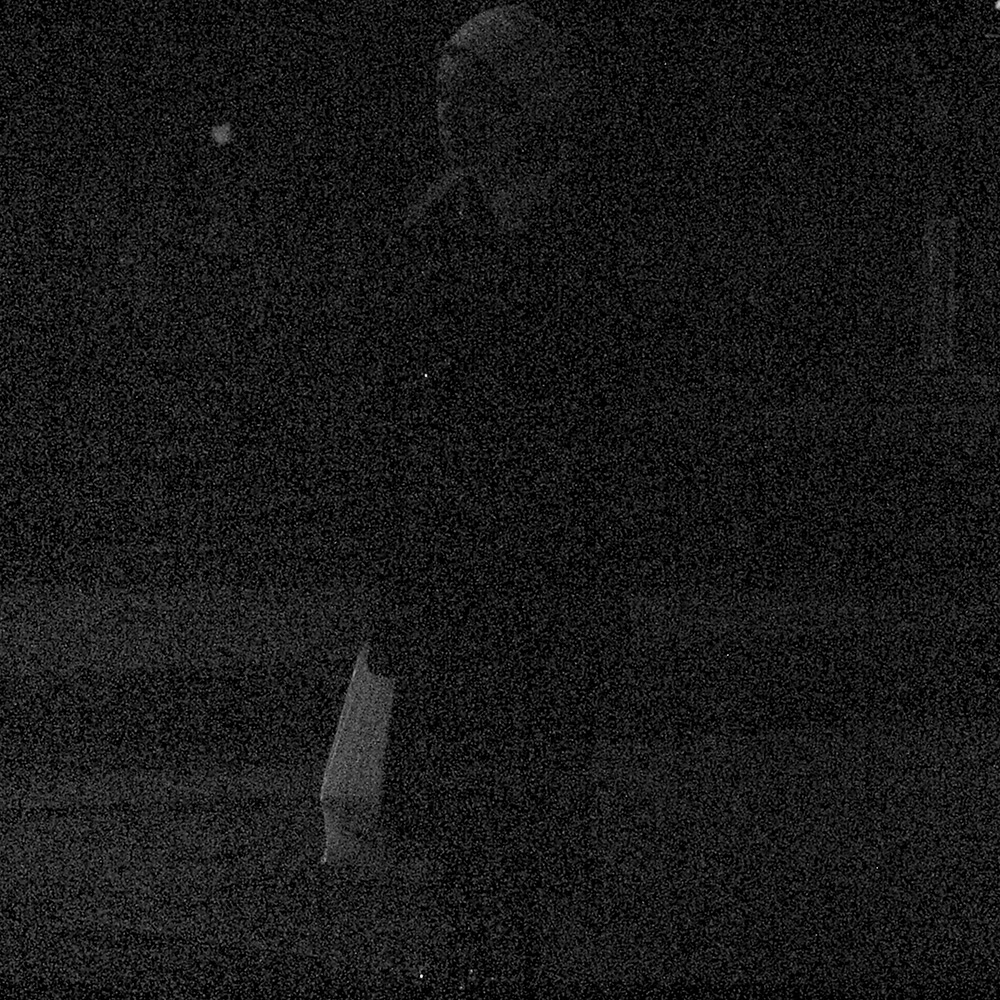
A Jewish Girl
|
Puck Thissen
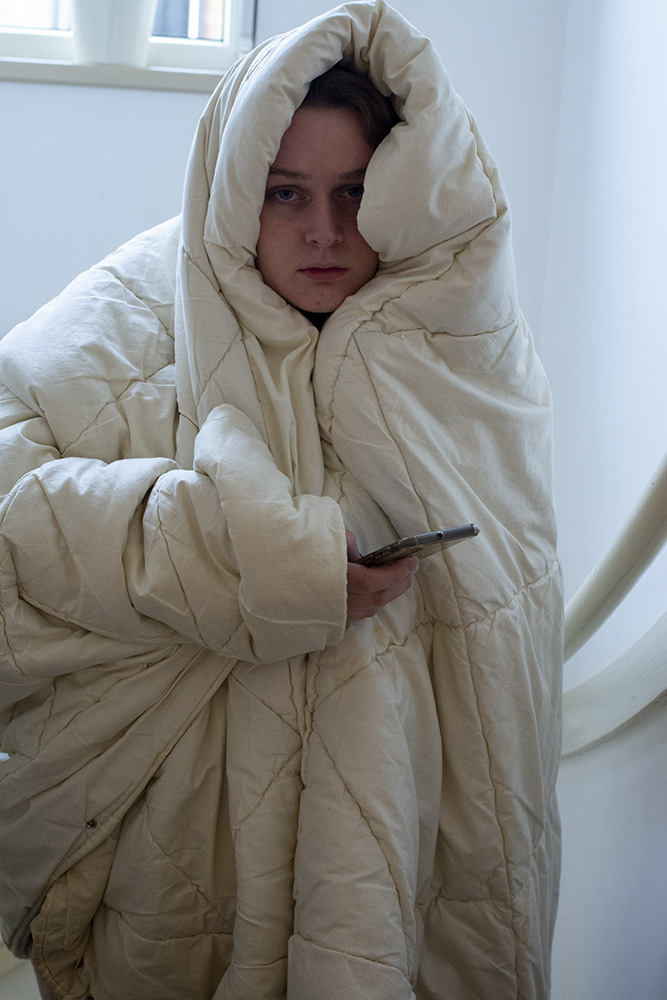
The psychological approach to myself. Lately I feel exhausted. The only thing I do is sleep and check my phone. I’m standing on stairs, on my way from the couch to my bed.
I used a 35mm lens, to show a little bit of the background. I used F/3.5 so most of myself would be sharp, and the viewer focuses less on the background.
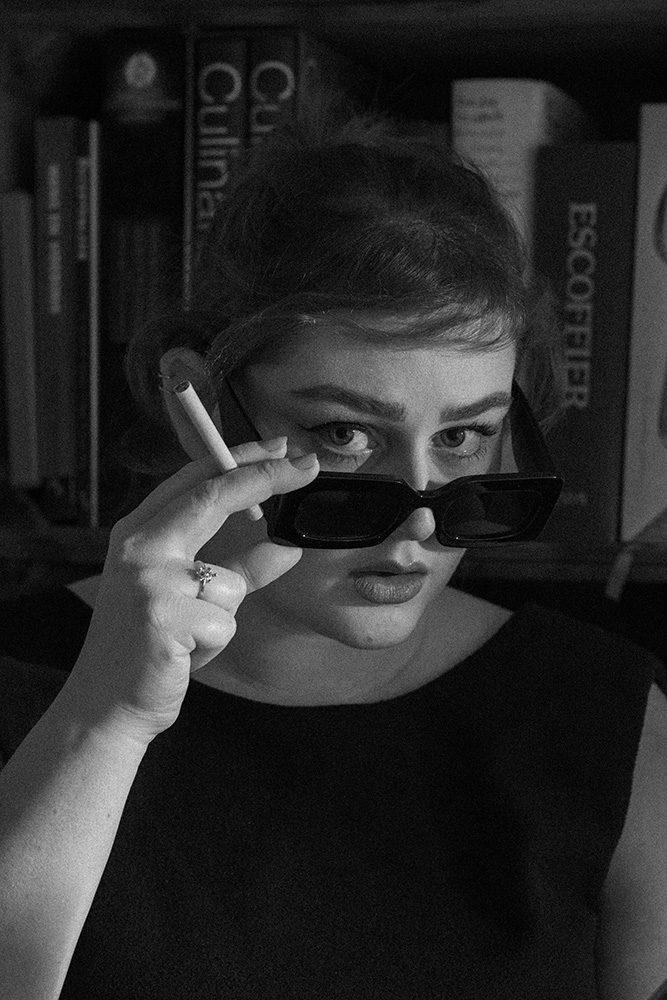
I transformed myself into Audrey Hepburn in Breakfast At Tiffany’s. She always looks so classy and I would love to be at a 50s party right now, one like in the movie.
Books seem high-class, so I’ve used those as my background. The sun was setting, which resulted in a beautiful light. Since I didn’t have a tripod, my brother held the camera and I connected it to my phone to do all the settings and take the photo myself.
|
Robert Sasarman
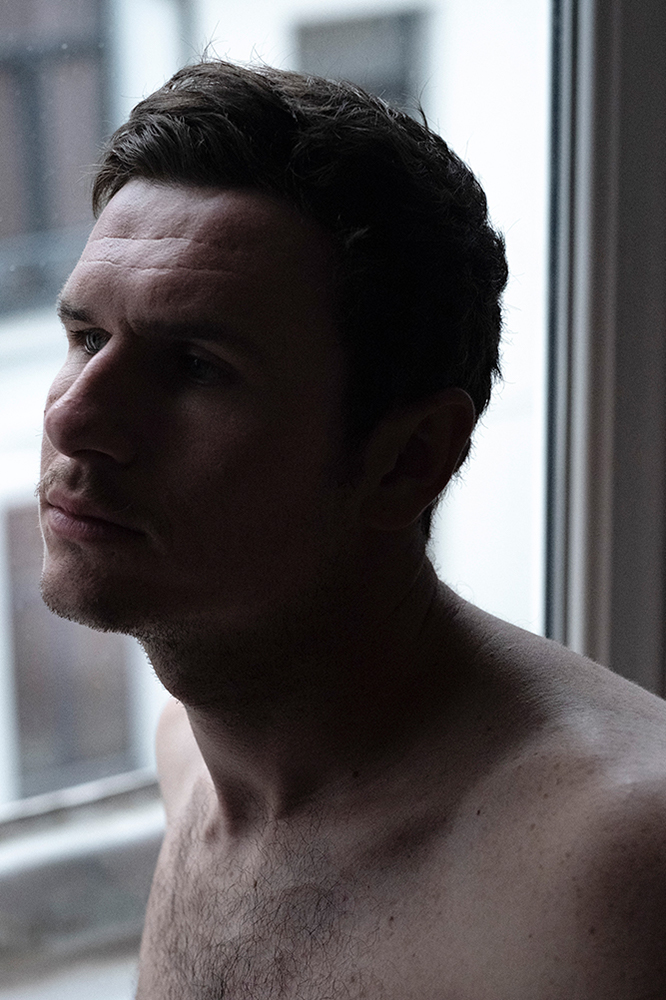
The self portrait is a honest and simple representation of myself where I focused on expression and body. I wanted to portray a feeling of being lost in your head, zoning out let’s say, no connection to your head, or you body. The focus of my face is in darkness, there is nothing that individualises me from a crowd. I am only a figure of a face and a body. Nothing more. I illustrated myself this way to show the disrupted connectivity I have to the world and myself, being merely just a figure in a window frame, like the most of us right now. I used a 56 mm lens, from a slightly higher angle, to make myself smaller, and “less than”.
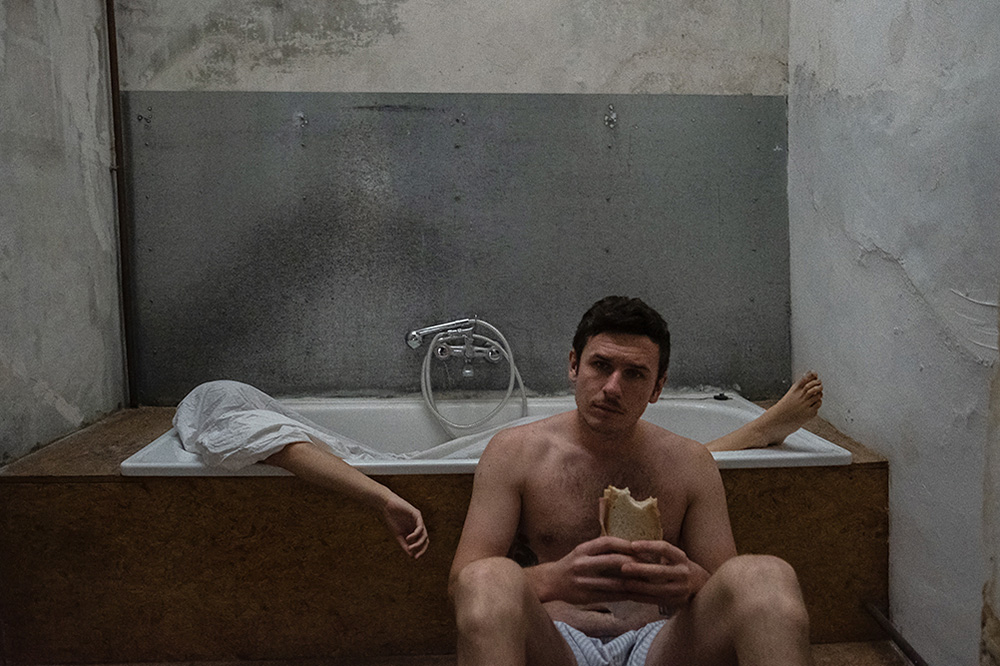
The construction of the character was inspired by Jeffrey Dahmer’s murders, more specifically that after he would murder his victims, he would interact with them in some kind of sick way. He would photograph them in various positions, sing to them , and then also cut off parts of the cadavers such as genitalia, hands or head, for preservation. I wanted to show this sick intertwined feeling of affection and disgust through a dead, cleaned body in a bathtub, while the murderer sits half-naked next to it, eating a sandwich as if this were a normal Sunday morning.
I wanted to emphasise the dissociation of the killer, by making his face, and the picture itself darker, while letting only some details, such as the hand and the drape, visible in the picture to create a more subtle and personal feel to what was happening.
For this image I used a 16mm lens on a mirror-less camera where I used a higher ISO in order to get a more textured image. No additional light was used.
|
Sarah Kirchner
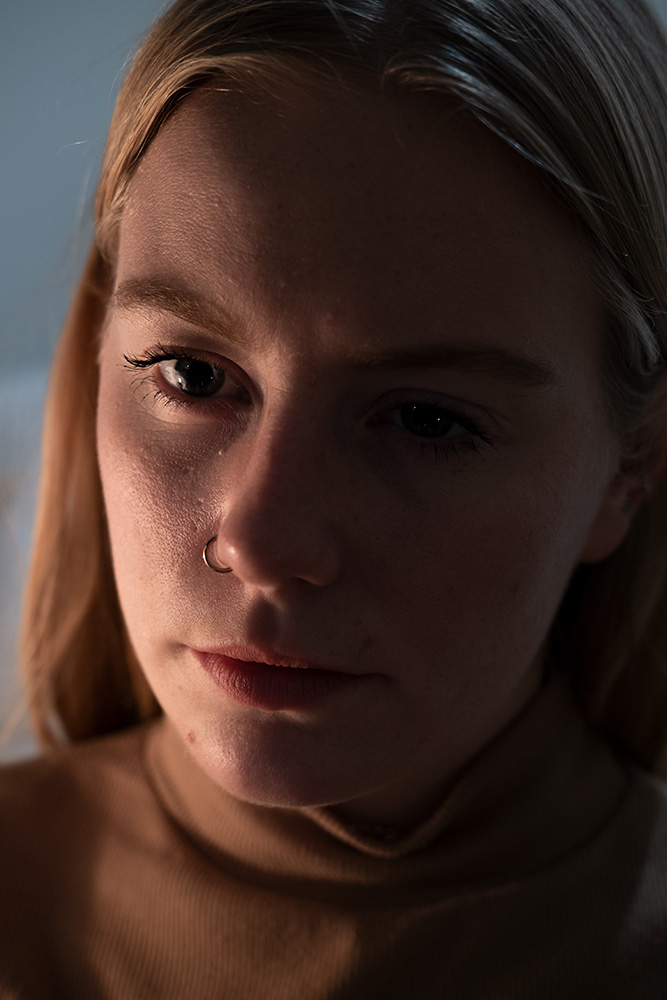
What you can see is the shell, the physical body. You come very close yet you stay on the surface.
You can read the face and see the rawness of the skin, yet what happens behind stays hidden.
There is a constant interplay between light and darkness on the exterior as well as within.
I didn't want to give away too much information about me. I didn't want the viewer to be able to
read me. In contrast to that is the physical closeness.
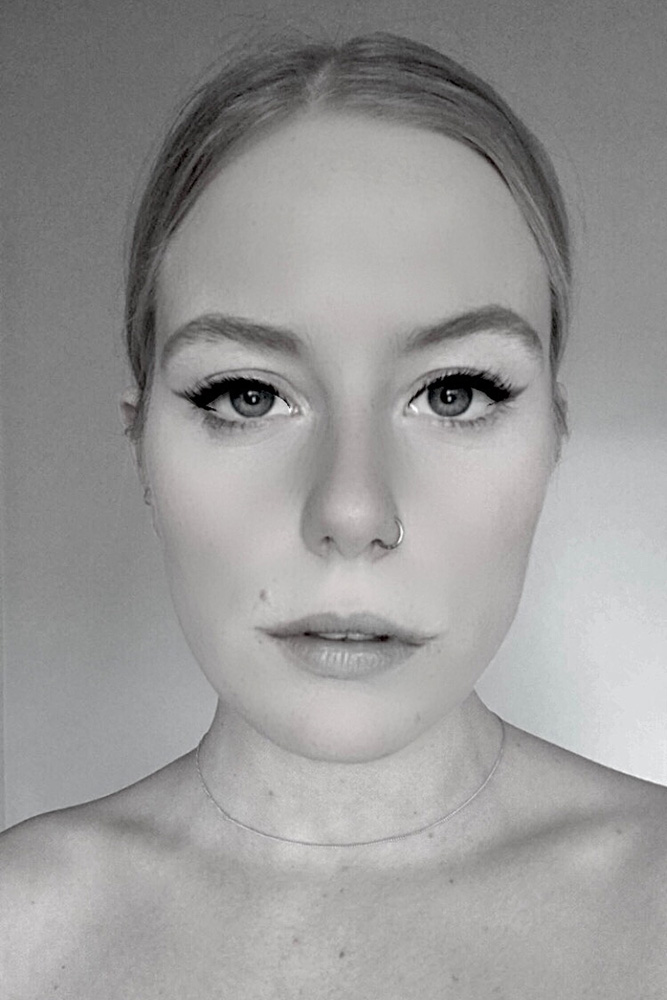
I transformed myself into an “ideal” version. This ideal version was not created by me but by one of the most popular Instagram beauty filters. It is a mask to please the masses.
It smoothens out, reshapes, slims down and adds more volume.
I decided to go for a frontal flat view with even light to stress the association with the mask.
My chest stays untouched from the filter, showing my true skin texture and is therefor in harsh
contrast to the smoothened out face.
I put the image in black and white to put the focus on form and texture.
|
Sarah Stone
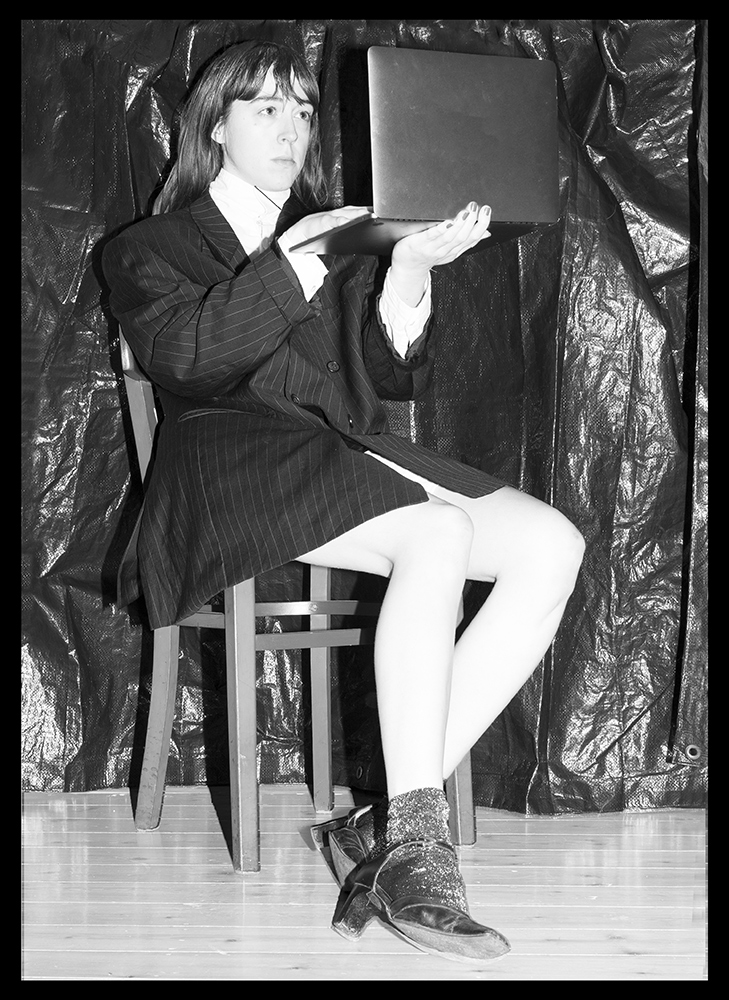
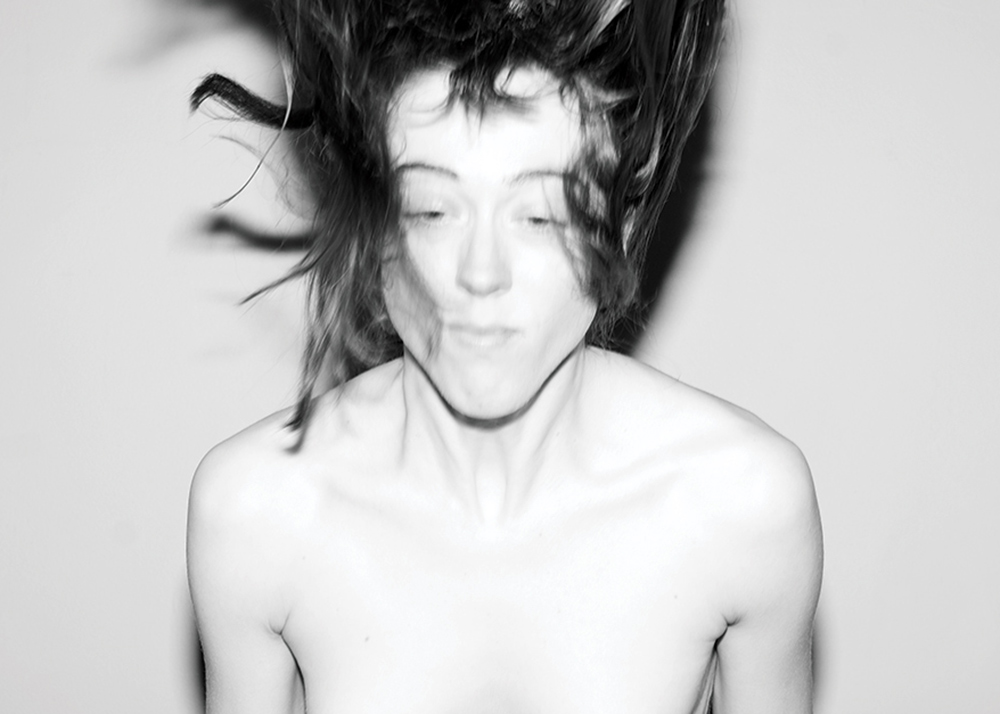
The psychological depiction of my `self` (entitled `ZOOM`) is a reaction to the increase of virtual meetings due to social distancing. I am responding to the physical position of the web camera. On most occasions during the meeting only the upper-part of body is shown. Those on the receiving side do not see the lower half of the body. This can mean that one may dress (professionally) above, but be dressed however they desire for the hidden half of their body. The constructed `other` is an attempt to re-create PJ Harvey`s 1993 album cover `Rid of Me` by capturing the movement of the hair with a captivating facial expression that engages with the lens. Both photos are shot in front of the same wall in my home which paves the freedom to express oneself at best. The neutral background highlights the characters of the self’s. The first changes from the second with the application of a material, an attempt to re-create a studio and provoke an atmosphere. The technique involves the use of a digital camera positioned vertically on a tripod that is either on its lowest stand or at eye-level. The flash is attached to generate light and therefore a low ISO and a medium aperture is used. The space is not small but not generous and the lens with a crop value is 40mm (pancake), hence the upwards point of view in image one. For image two the timer is used on the ‘two second' mark, allowing oneself to respond quickly to the rhythm of experimentation.
|
Sarah Van Wingerden
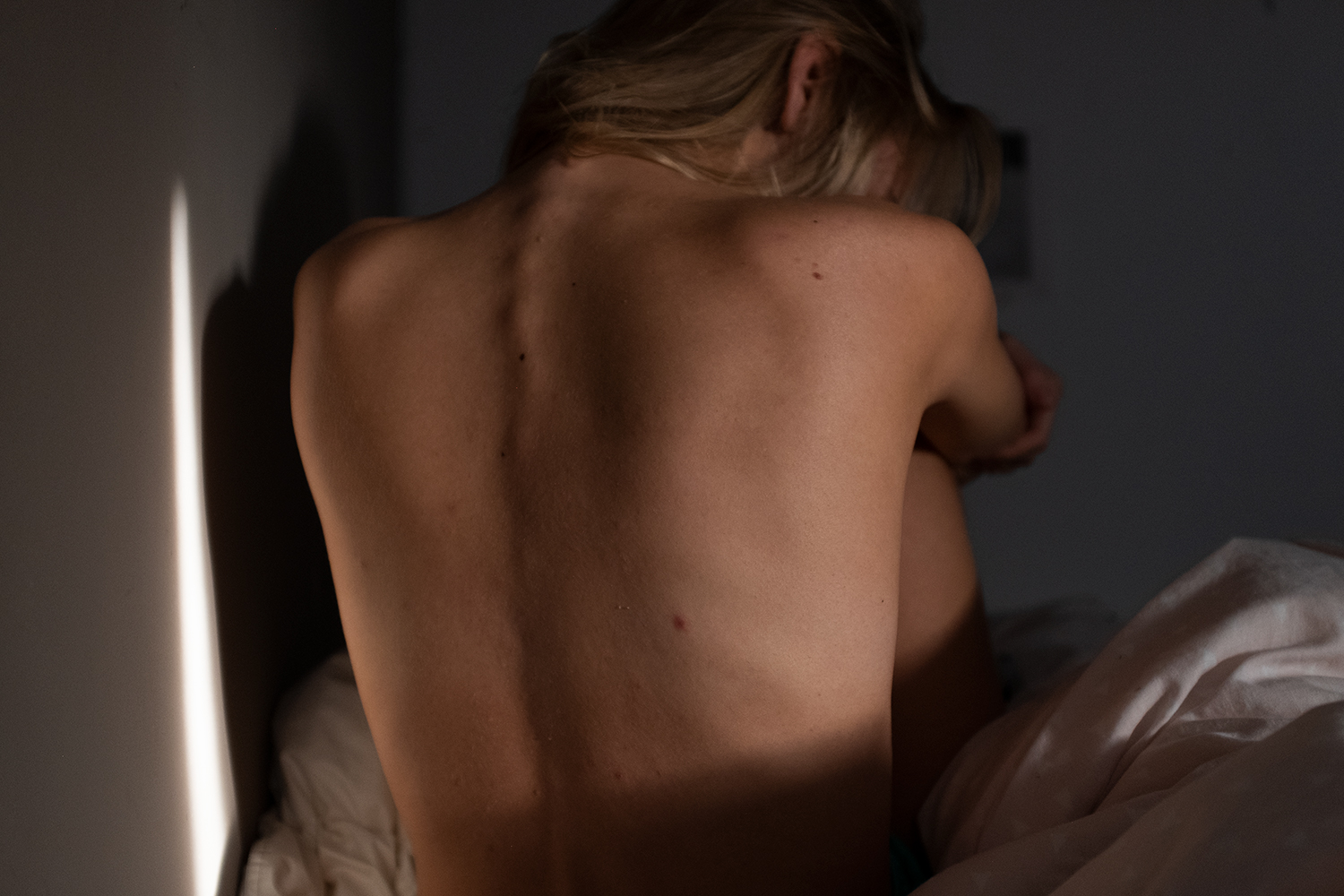
Mezelf in deze tijd. Kwetsbaar en niet helemaal in controle.
Mijn eigen veilige plek, mijn slaapkamer.
Zachte kleuren, om de veiligheid van de plek te laten zien. Lichtinval die net niet op mij valt. Mijn rug naar de camera, om een stukje onzekerheid en afgesloten zijn uit te beelden.
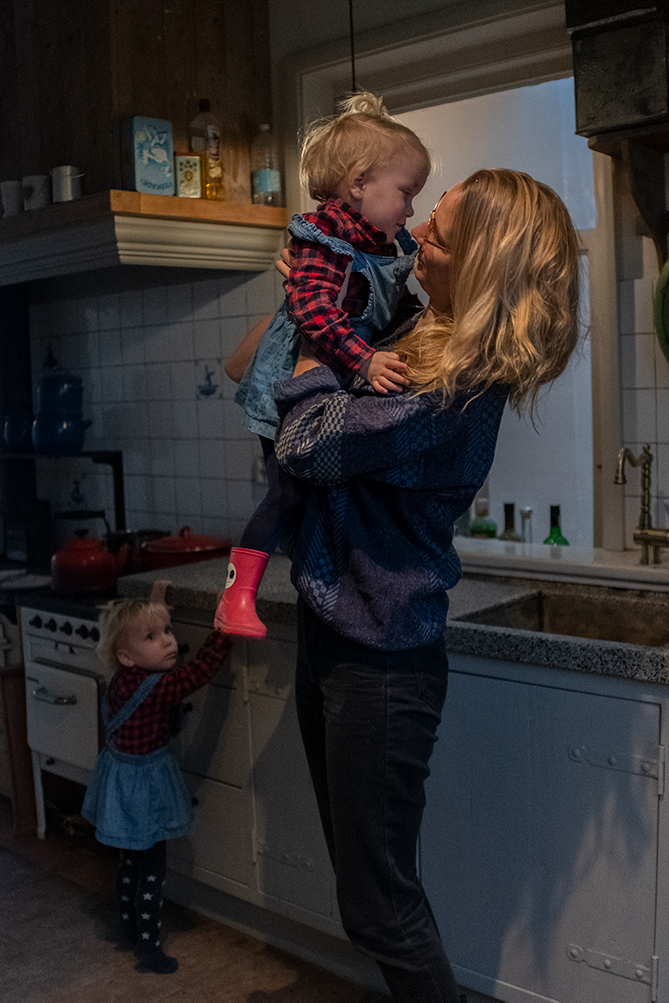
Mezelf in de rol van een moeder/ mijn zus.
In het huis van mijn zus (die een groot gezin heeft).
Je ziet het model helemaal en in een drukke omgeving. Het model is iets aan het doen. Het licht is natuurlijk, maar met wat licht van de lamp. Laat zien dat het in een huiskamer is.
|
Theo Scherer
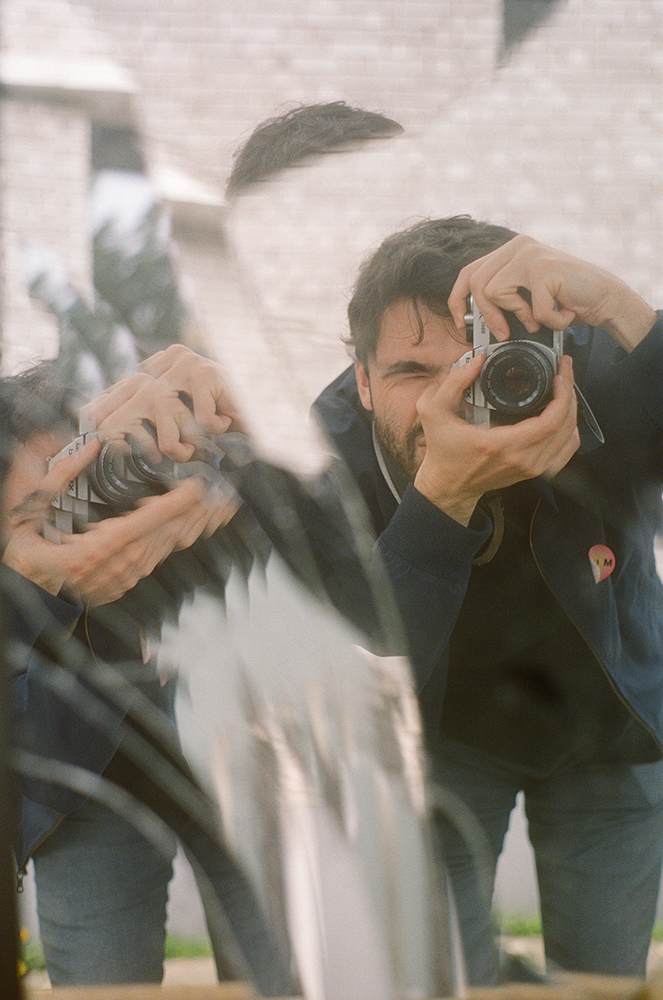
A broken mirror to reflect separate parts of me. It is difficult to understand every fragment of the self; not all perspectives are appropriate to see our self in its entirety.
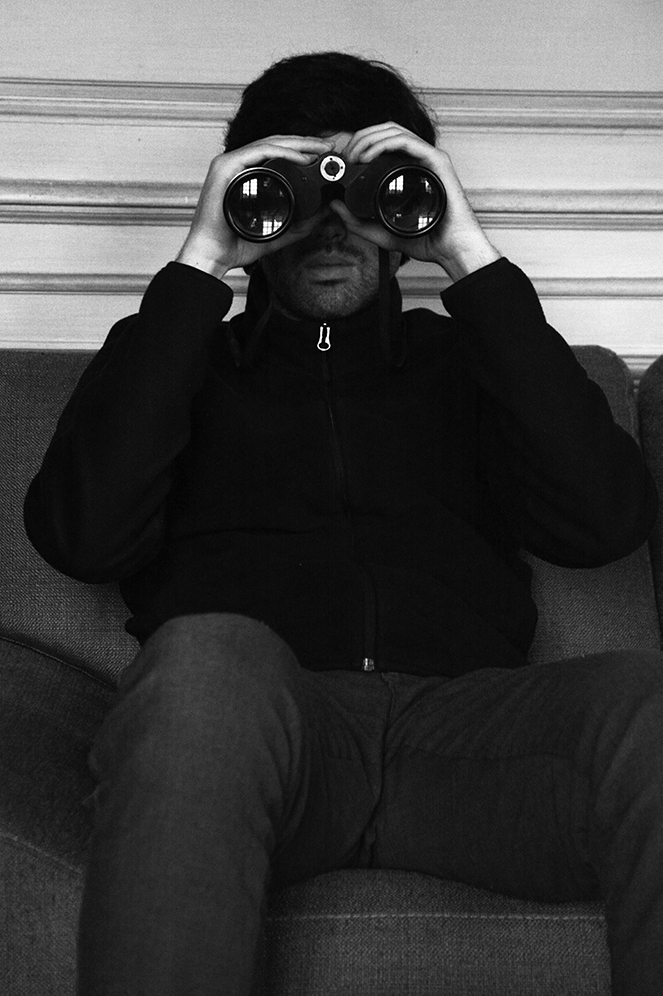
What is an observer without a camera? Is the photographer a voyeur? What better than binoculars to emphasize the act of the observer. I am watching the camera I set to catch myself.
|
Veronika Breuer
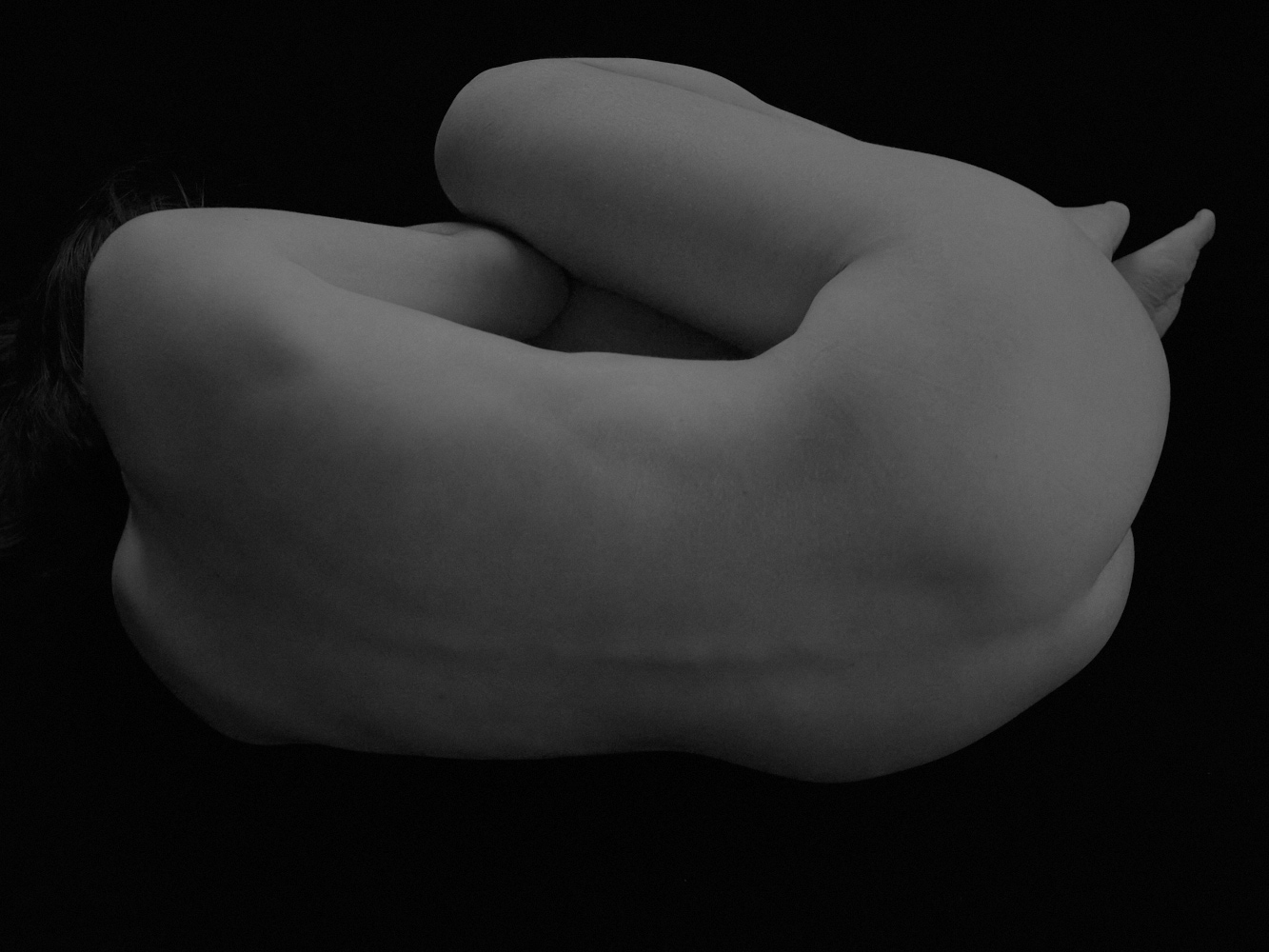
I want to hide myself and sometimes I want to break out, but mostly hide.
From people and happenings, from life, sometimes.
Time to allow soul and body feel.
I was inspired by the ultrasound pictures of babies, we can see the body and the life, nothing more.
I wanted soft, evenly spread light to be focused on all parts of the body the same.
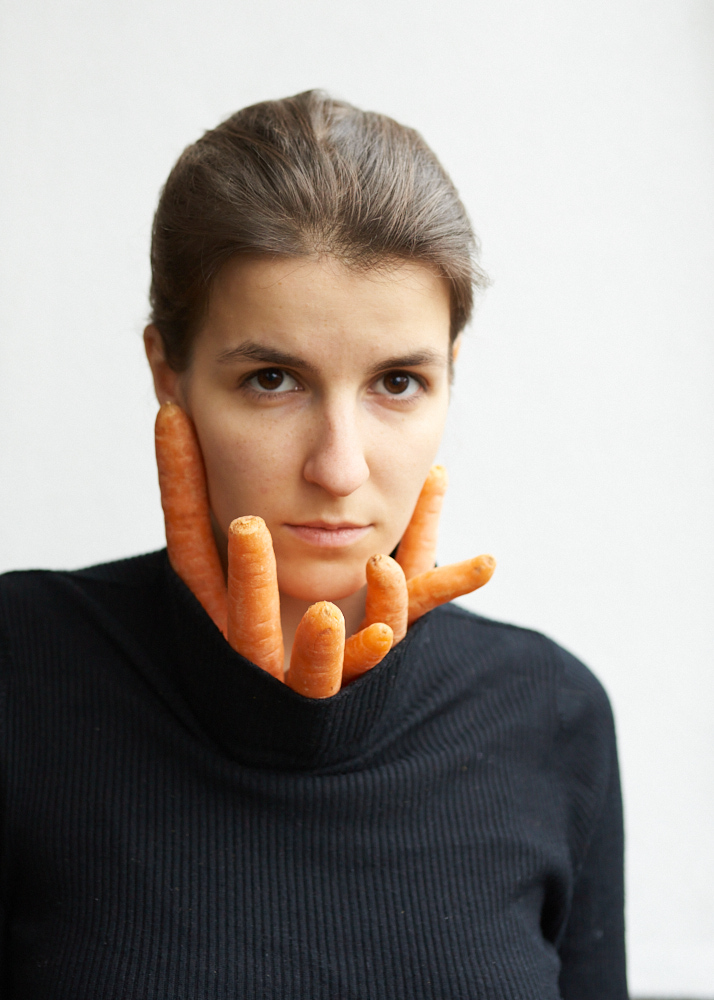
As Jan Hakon Erichsen
Whats in him?
I tried to place myself into his mind and create the picture with a white background as he would do, but didn’t wanted to use elements he already used. I though about it what he would might do. Of course, that I never know.
|
|
|
|